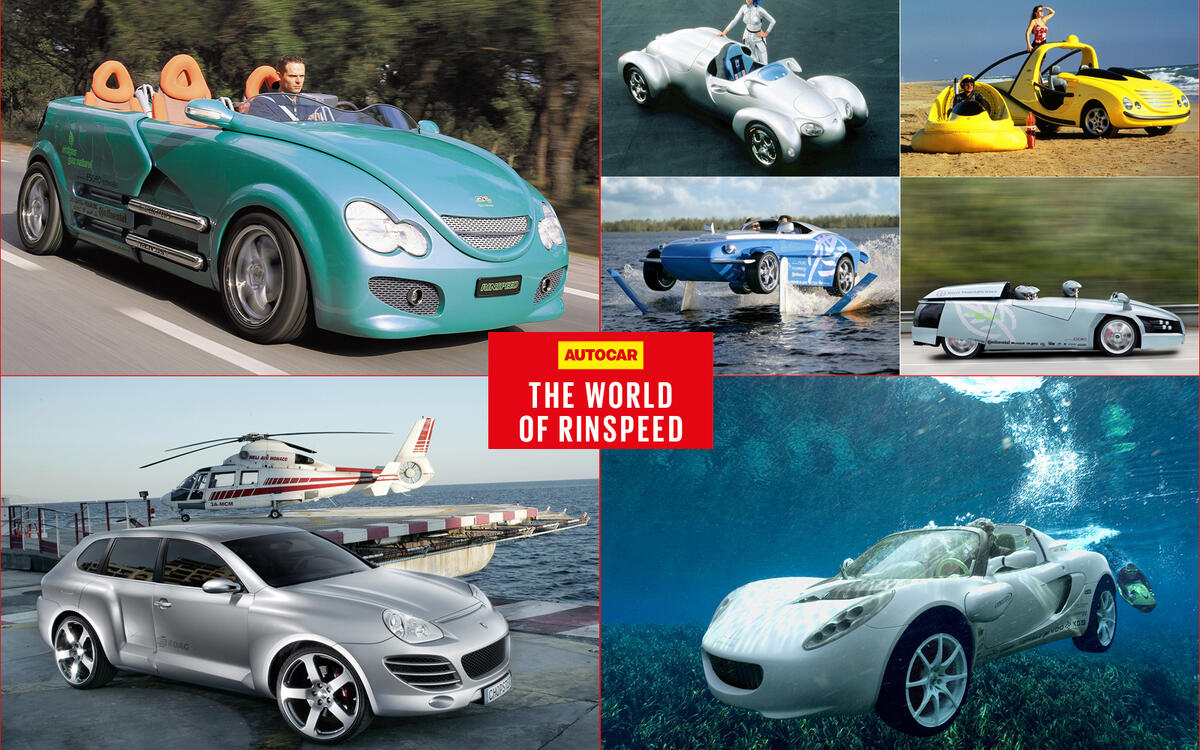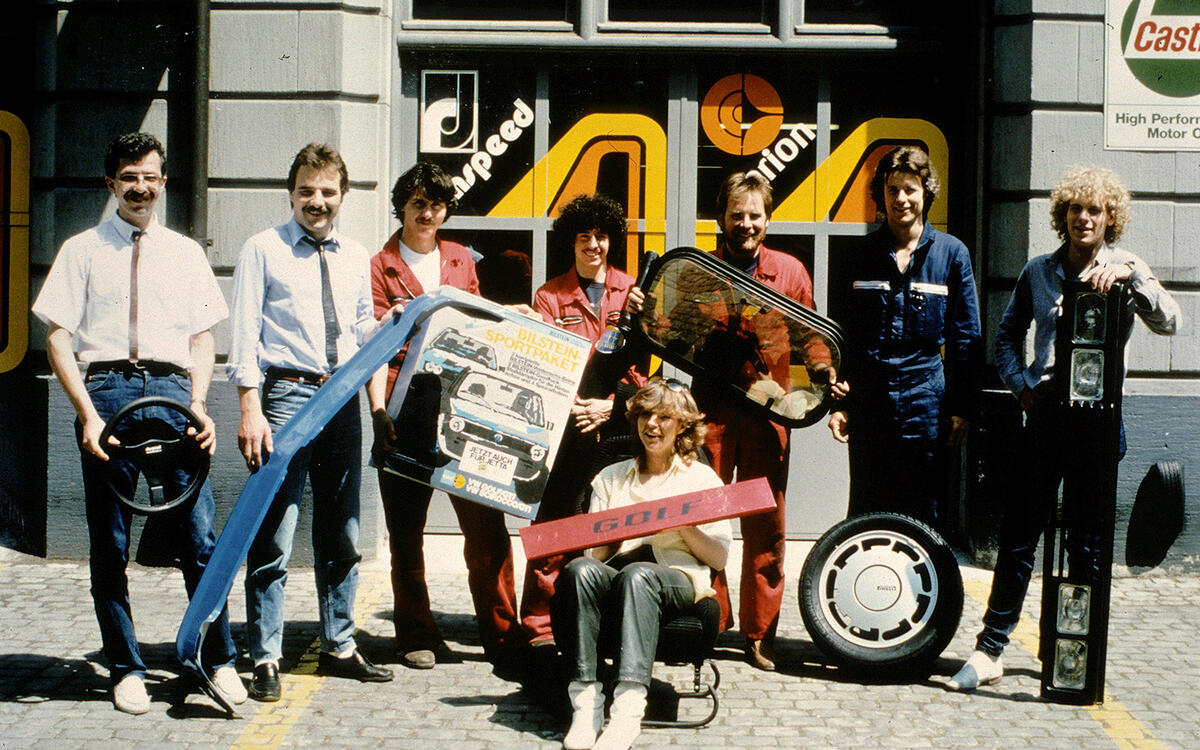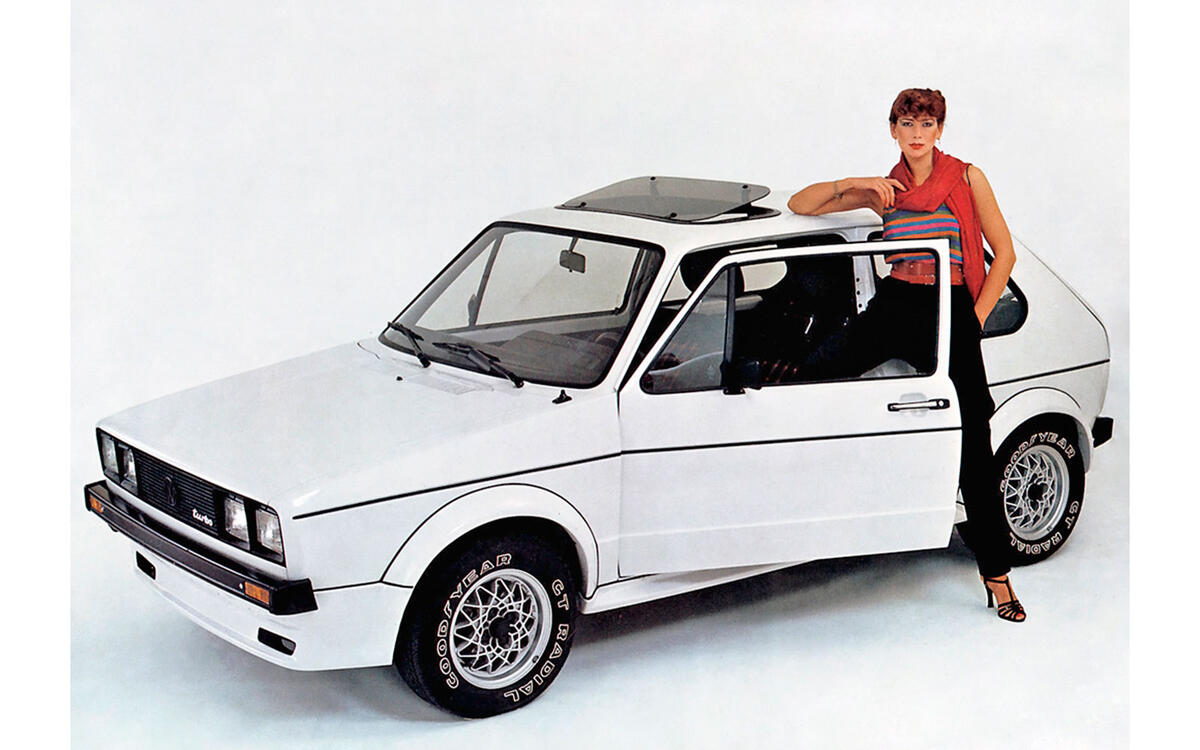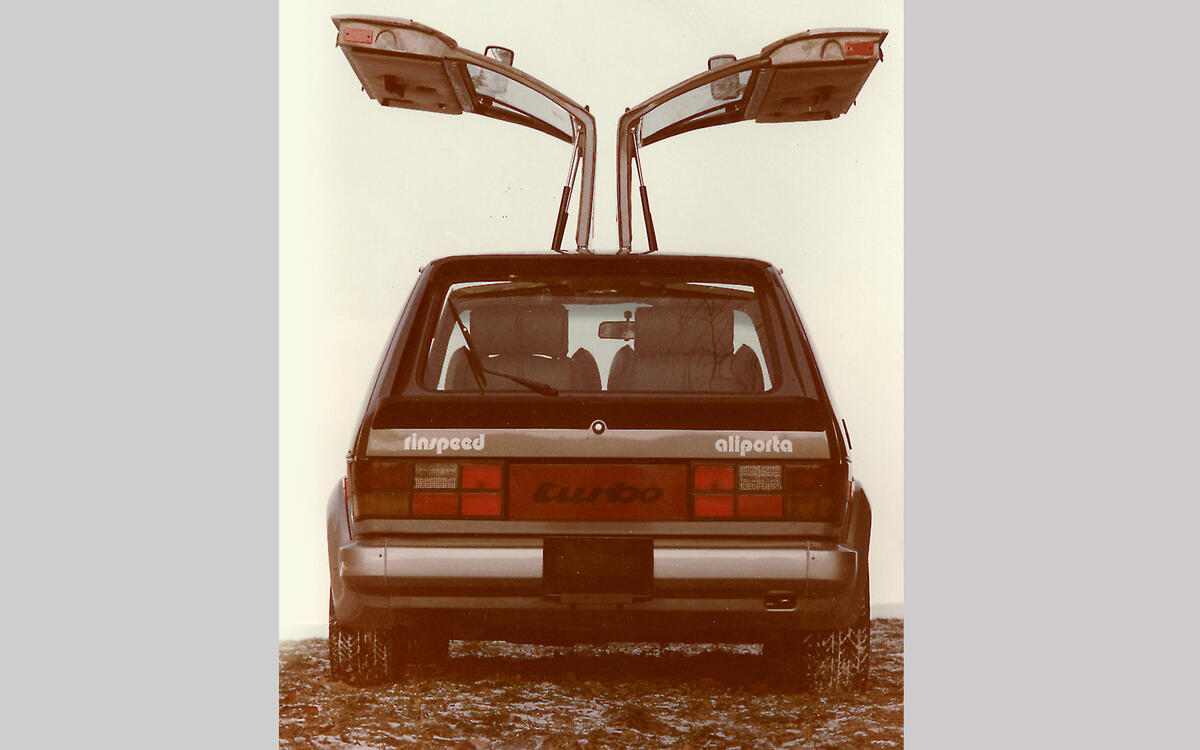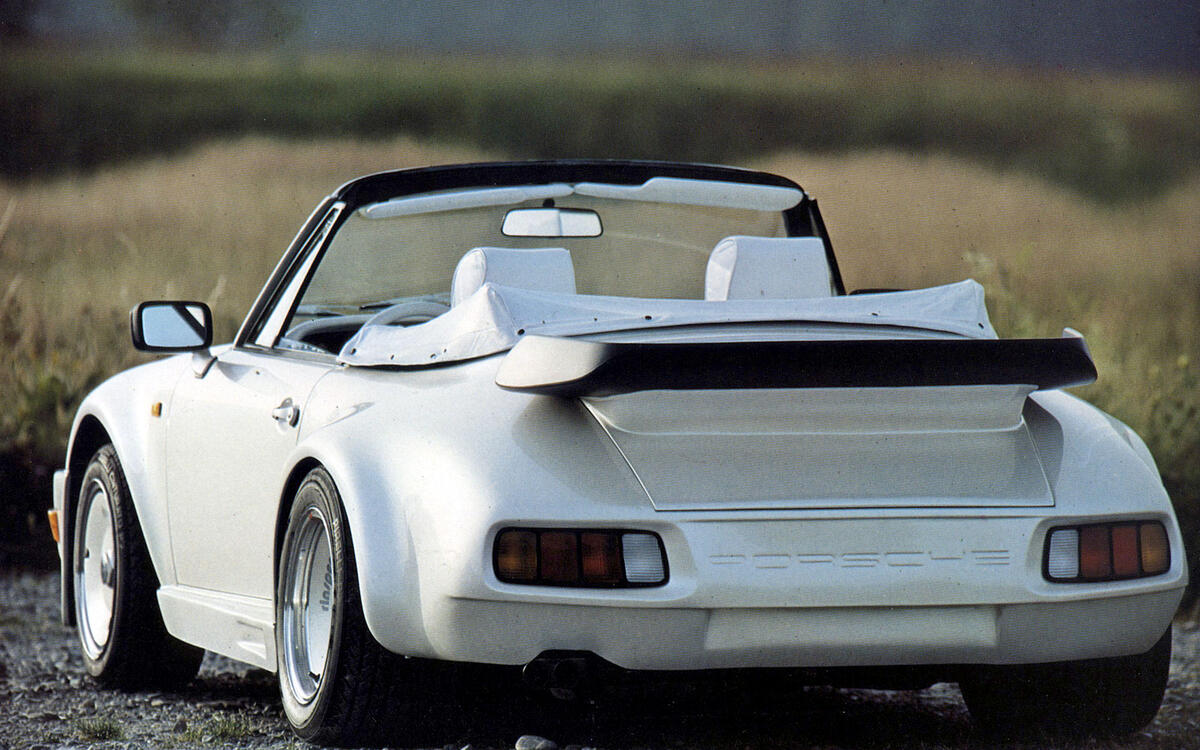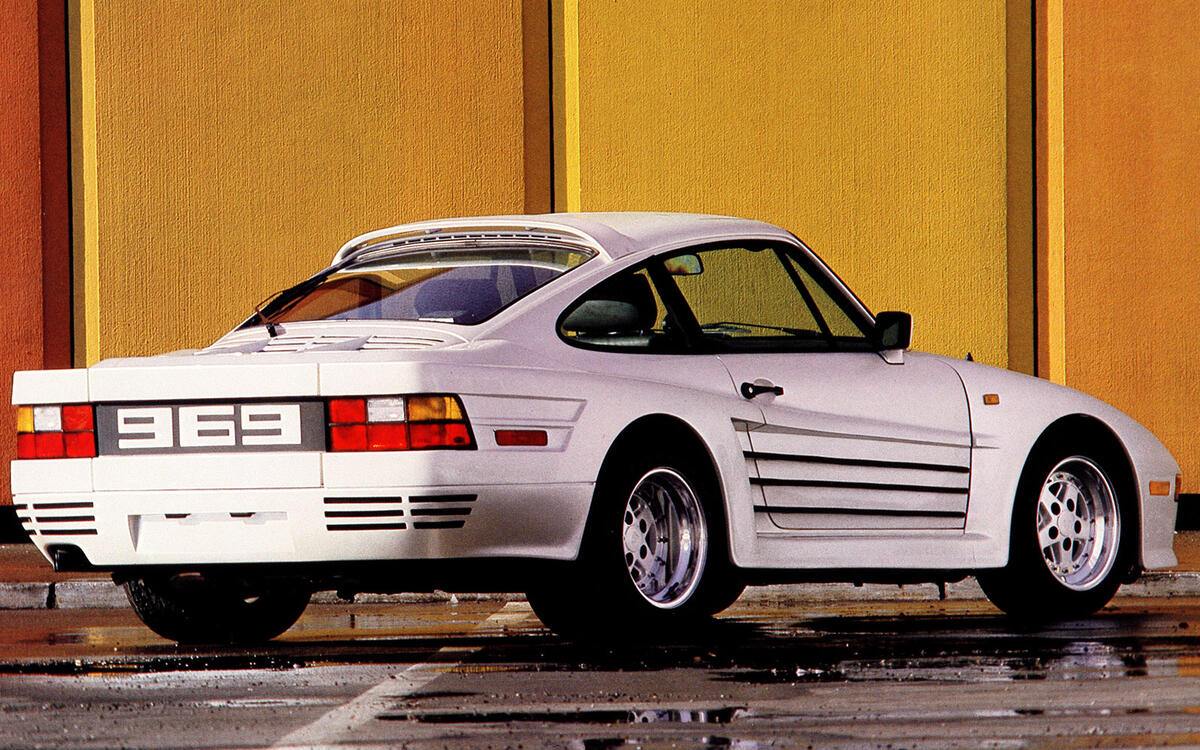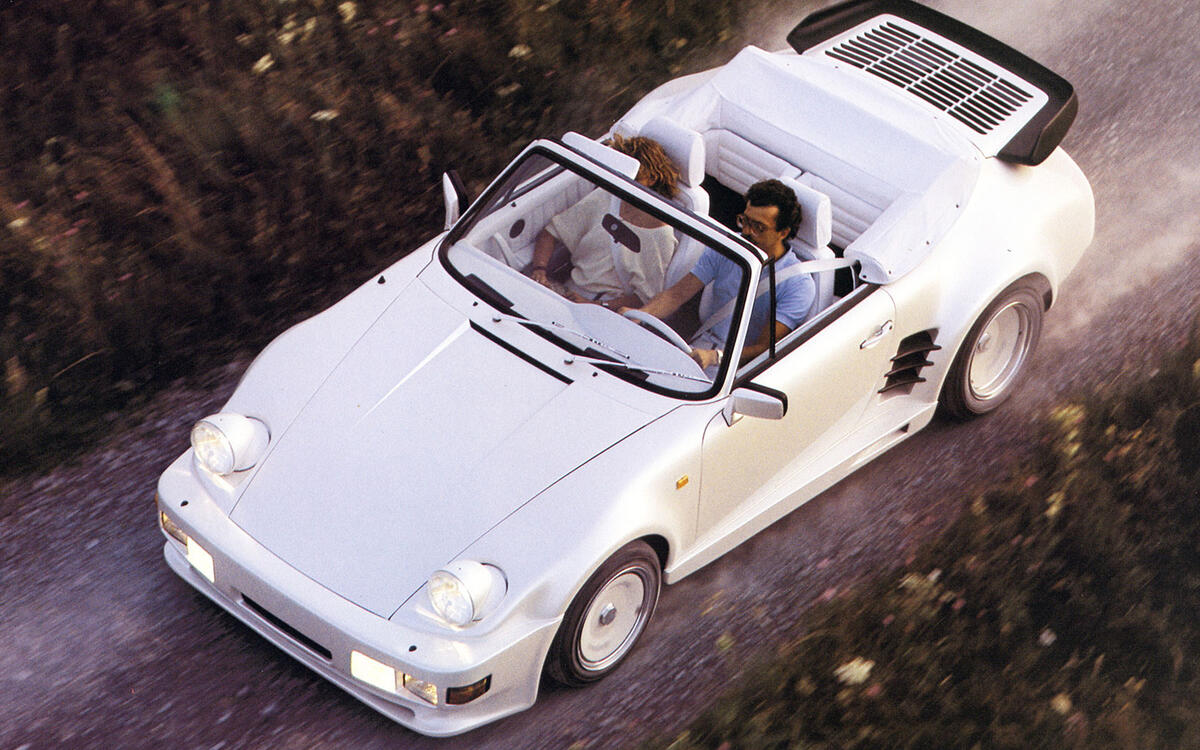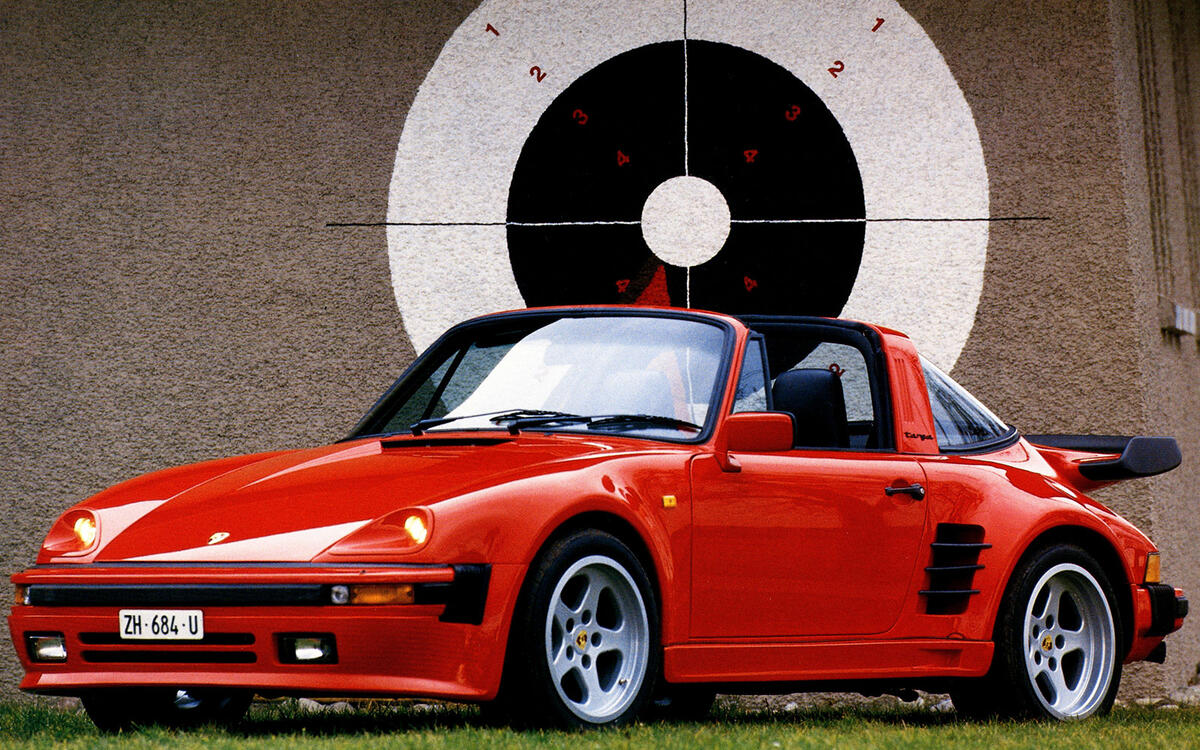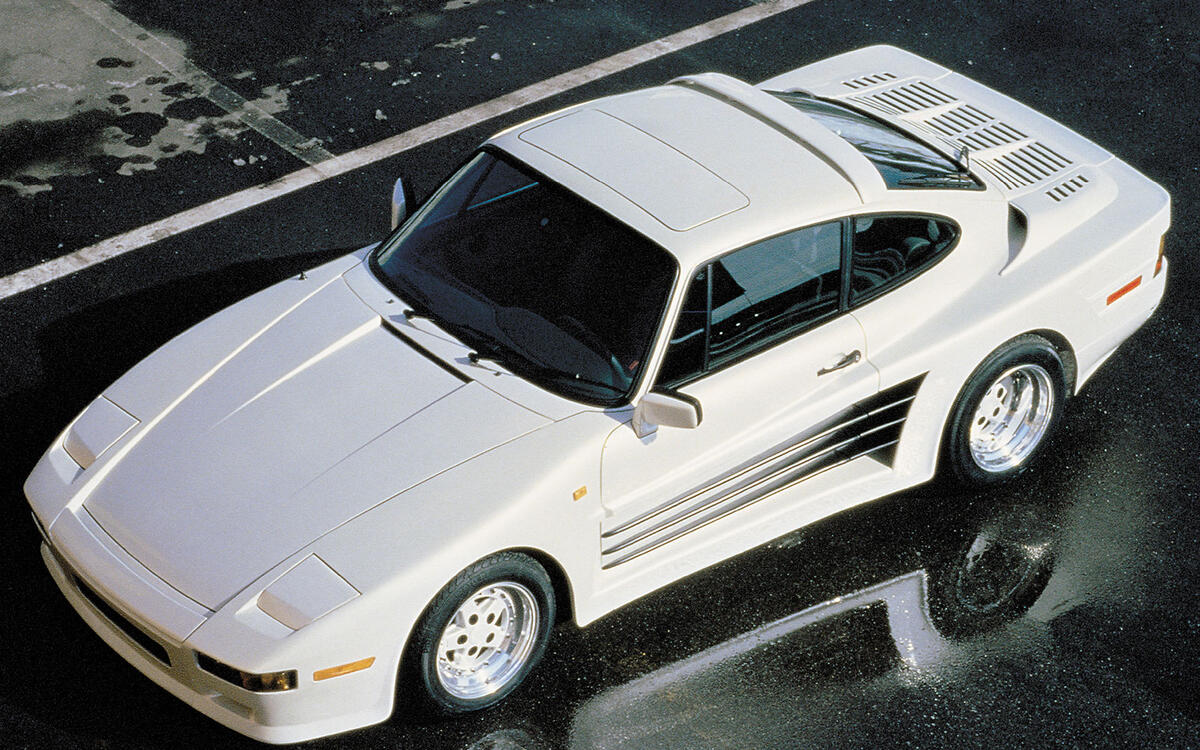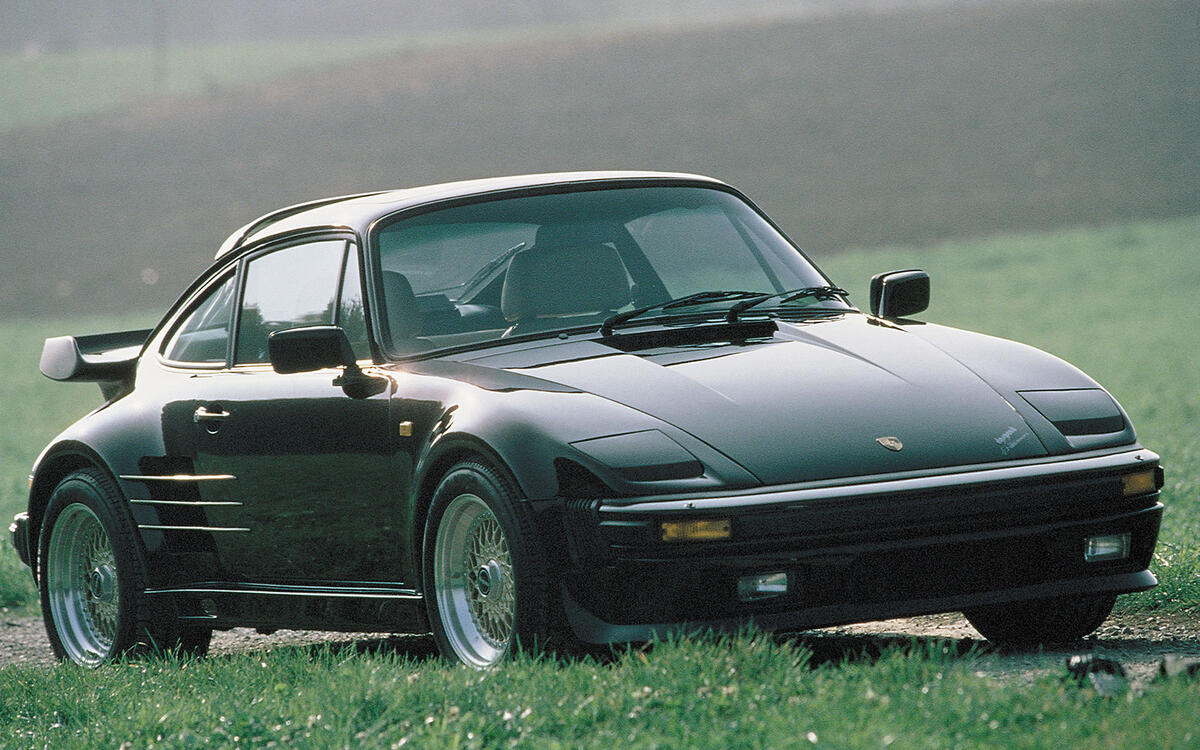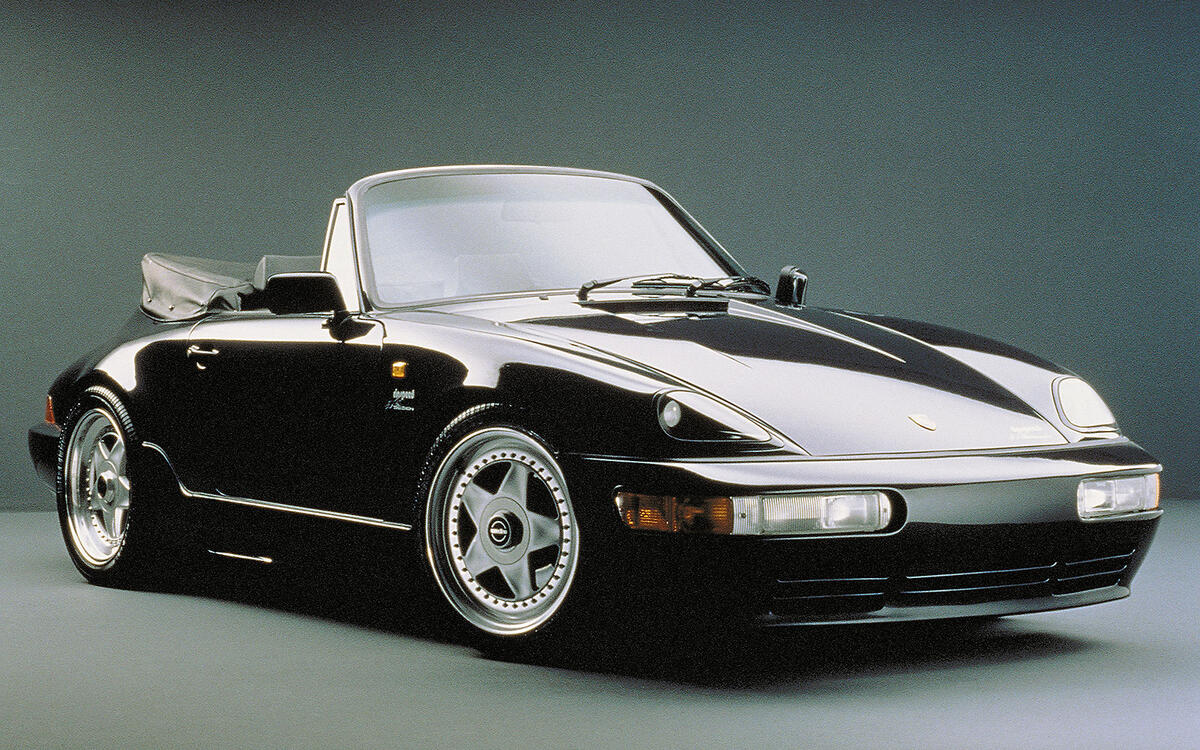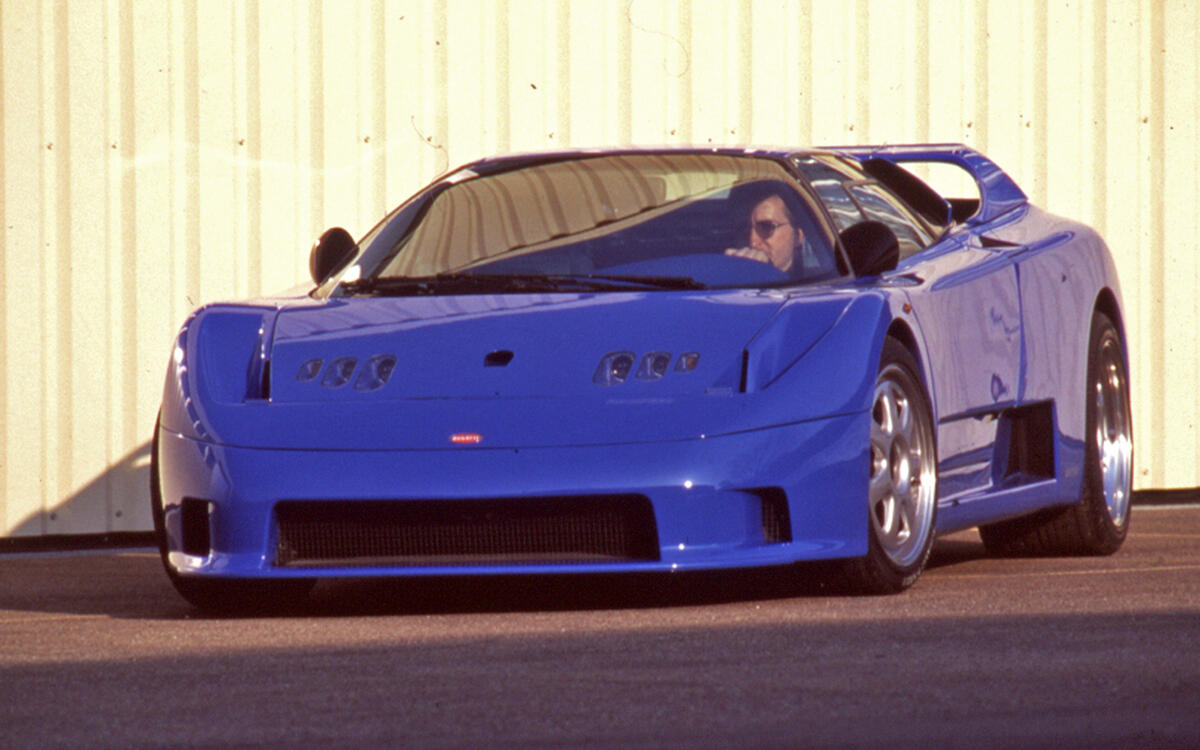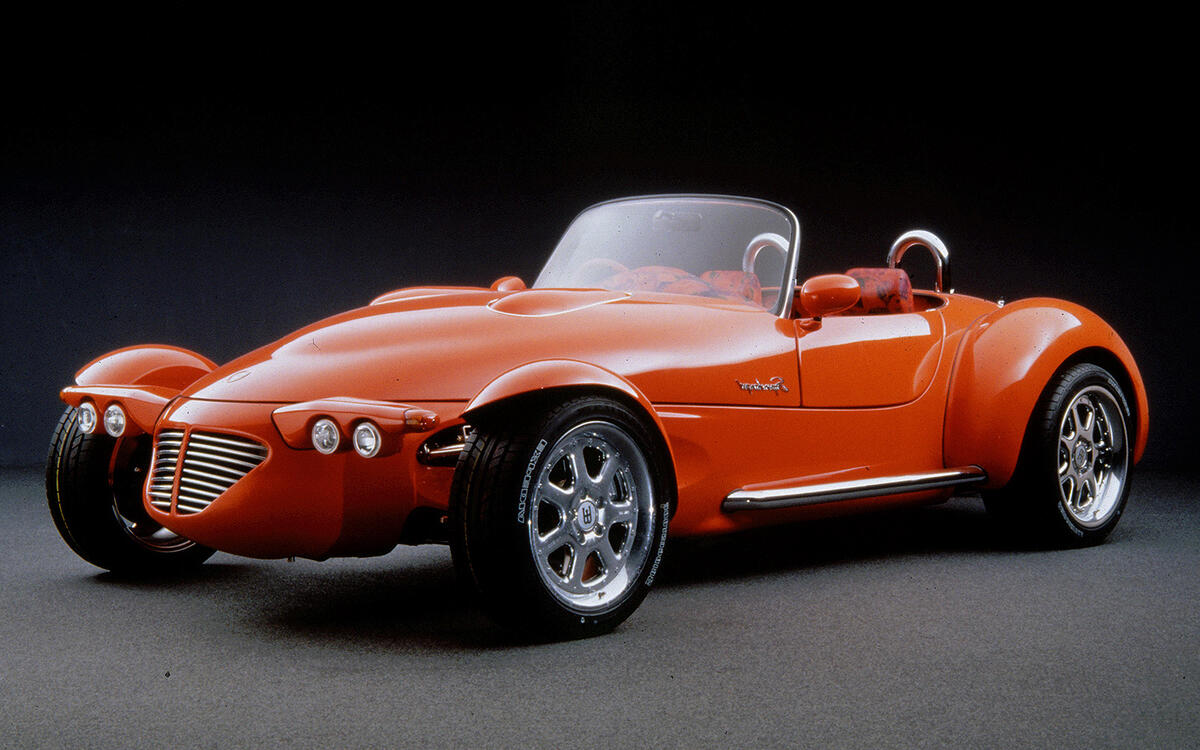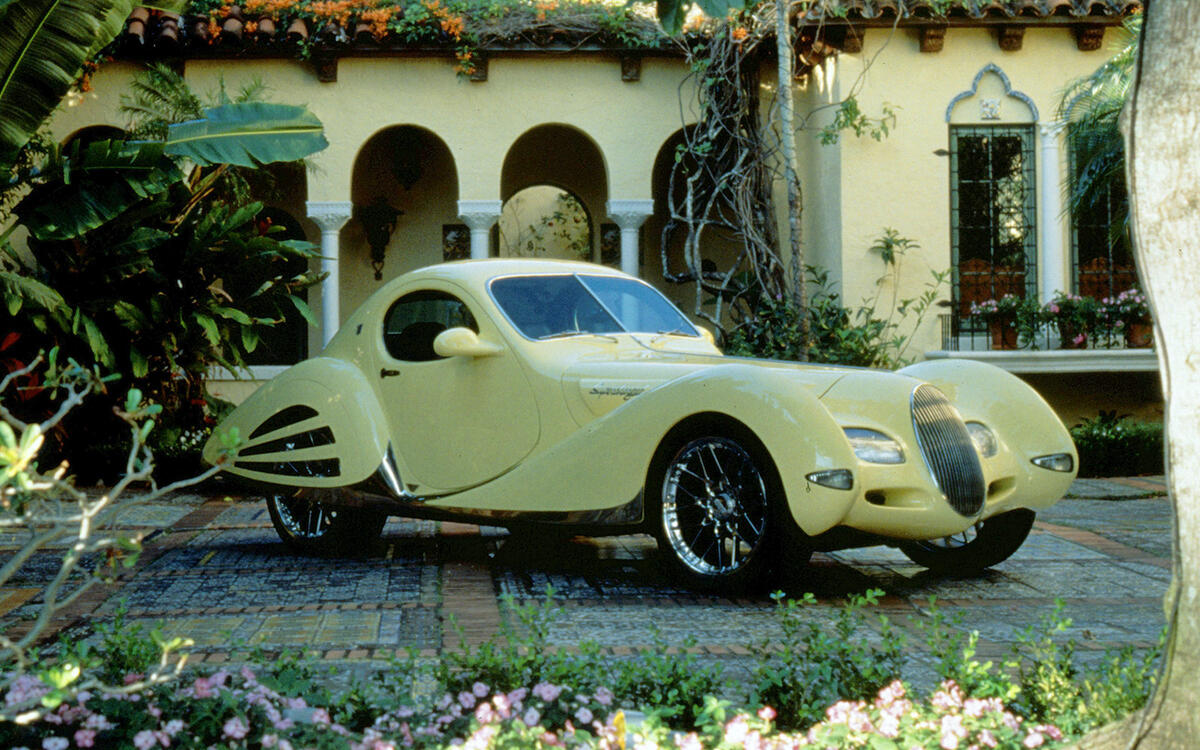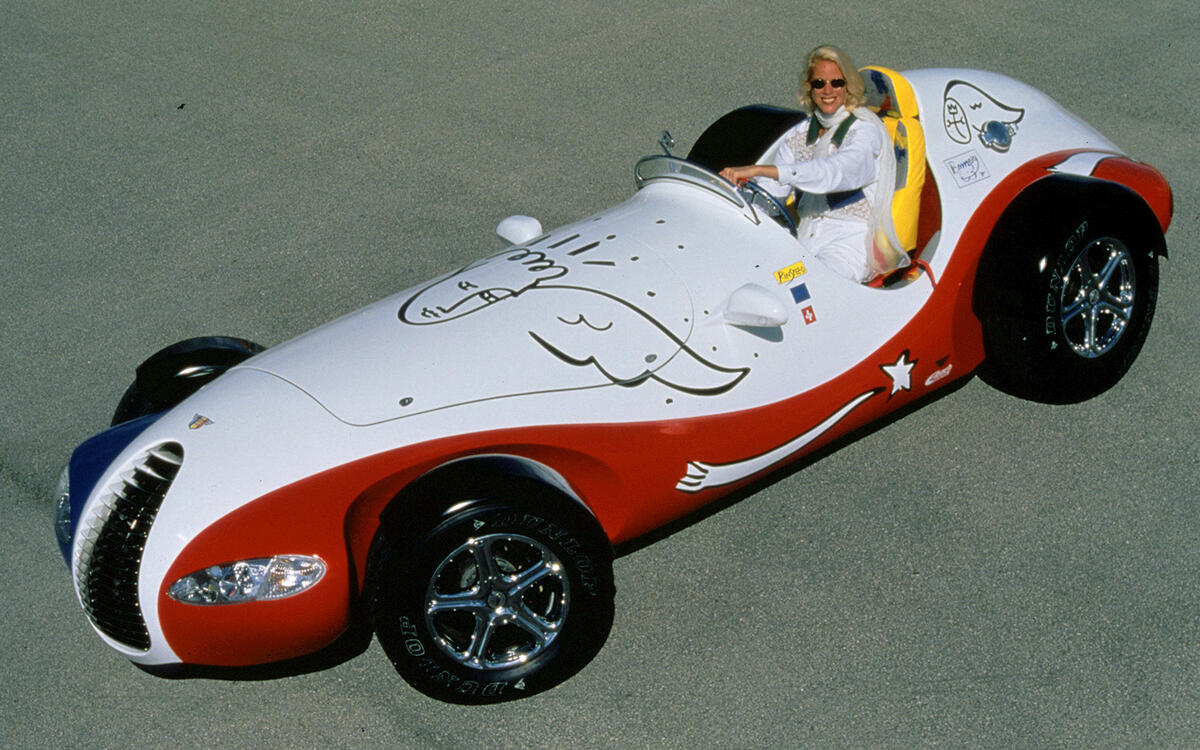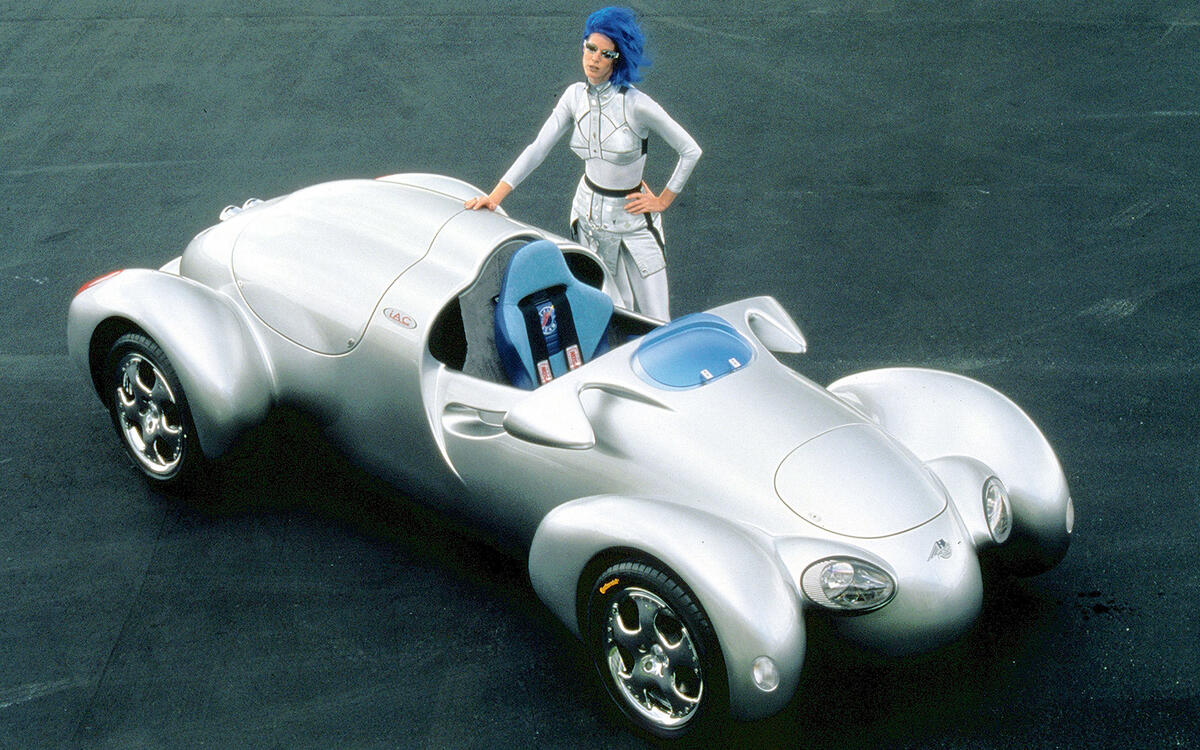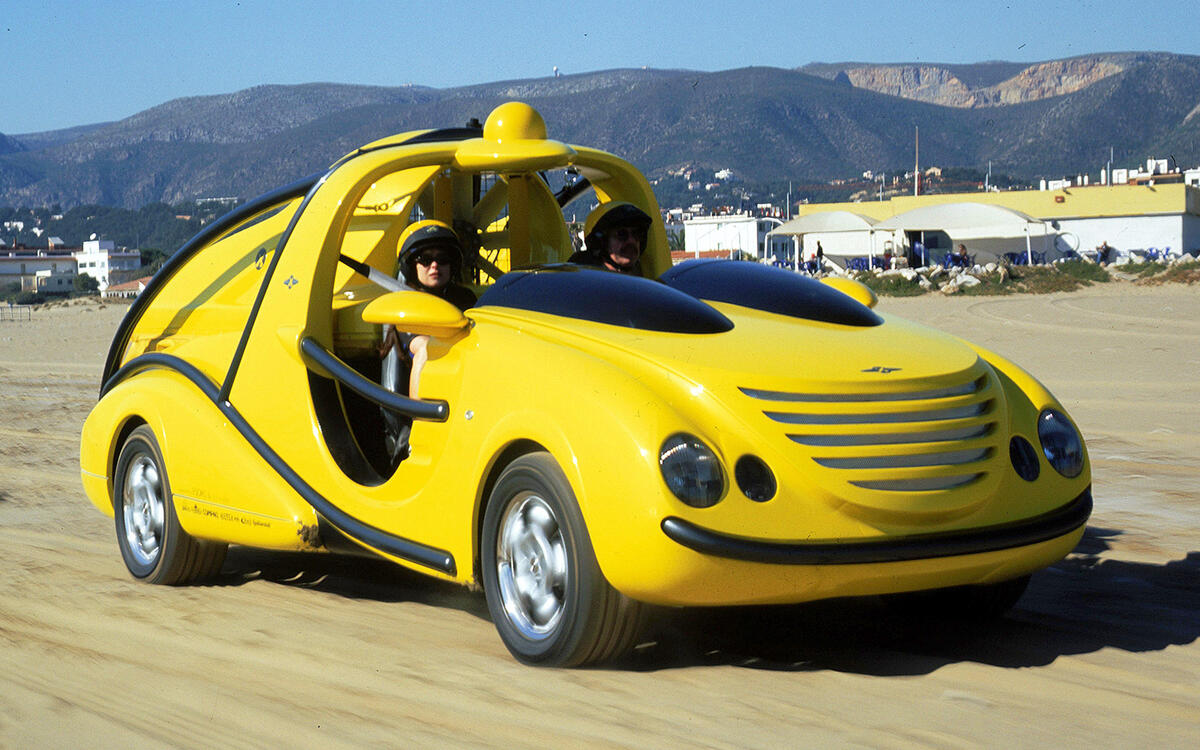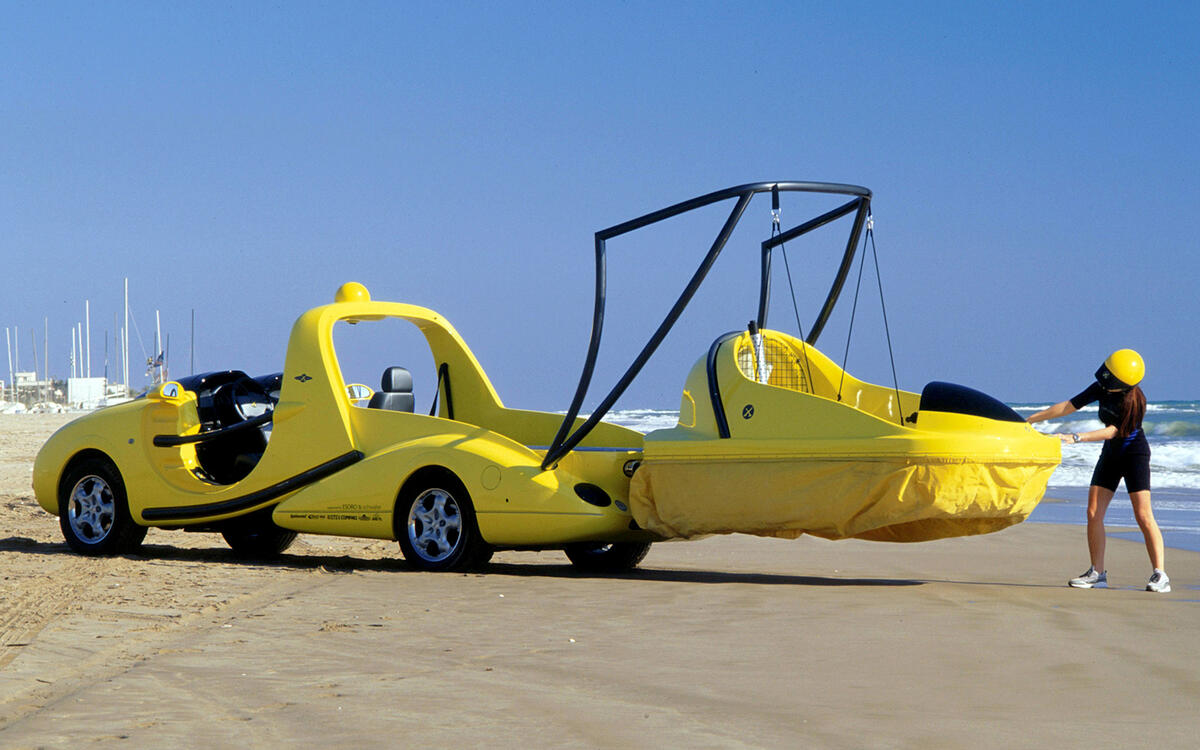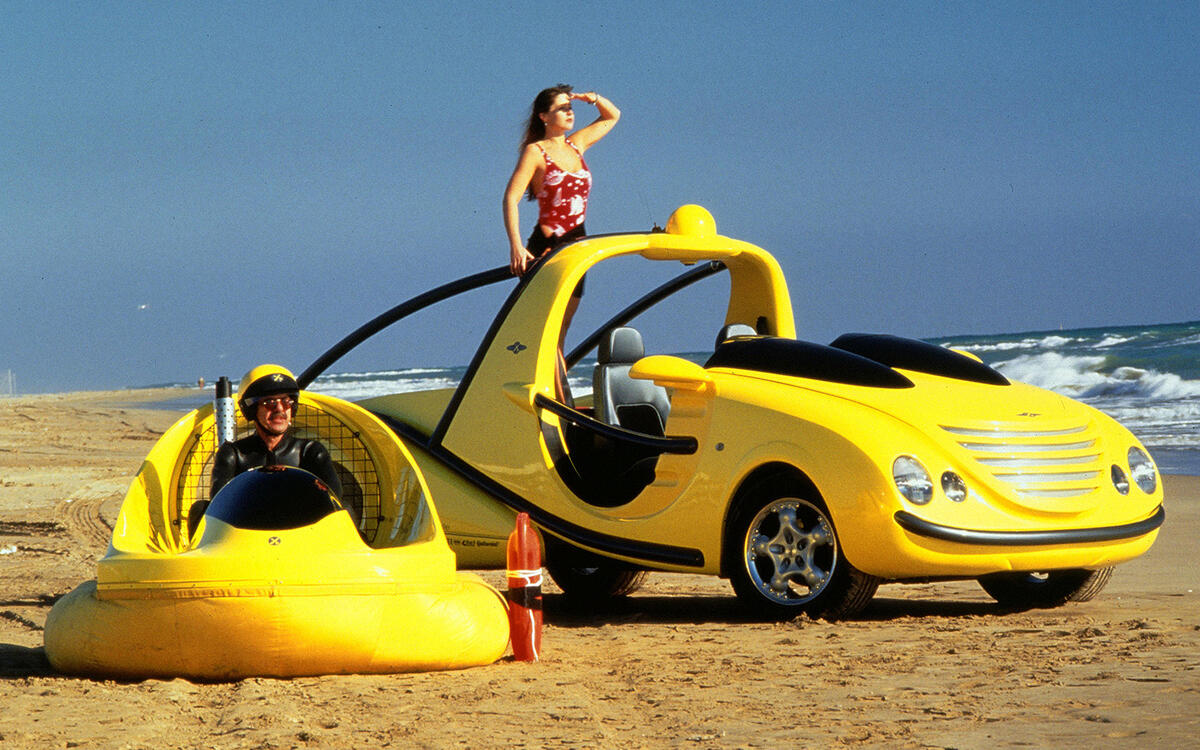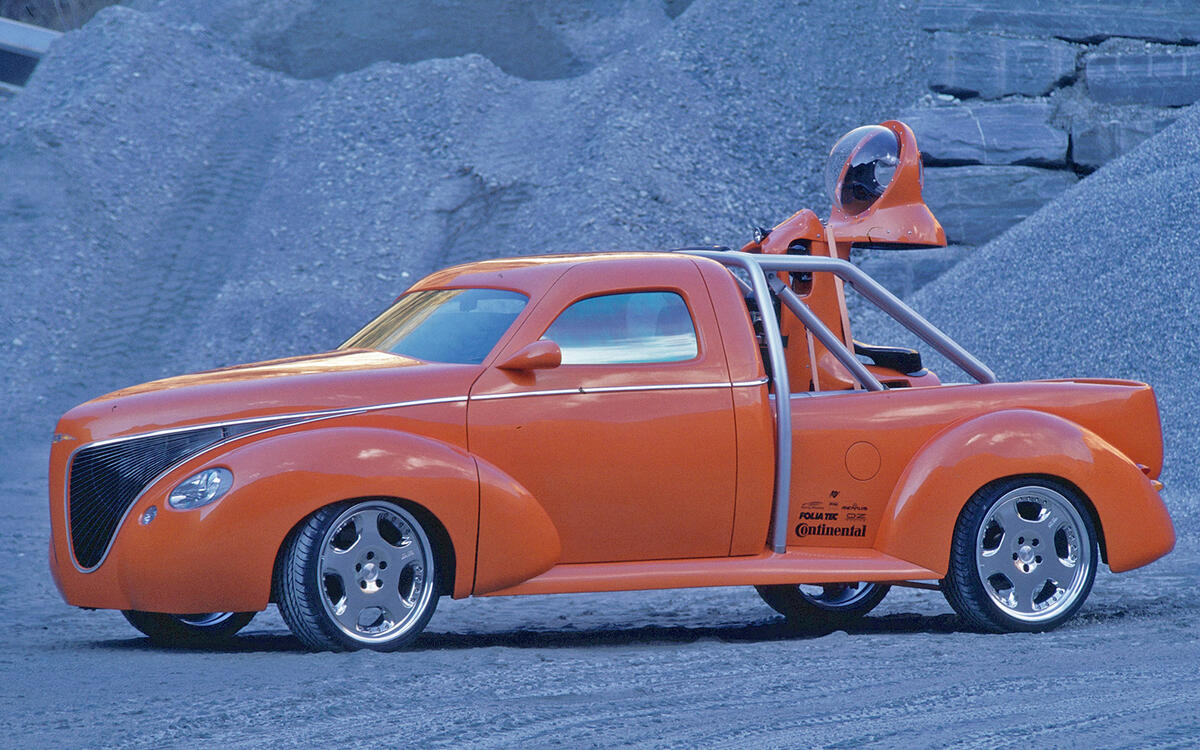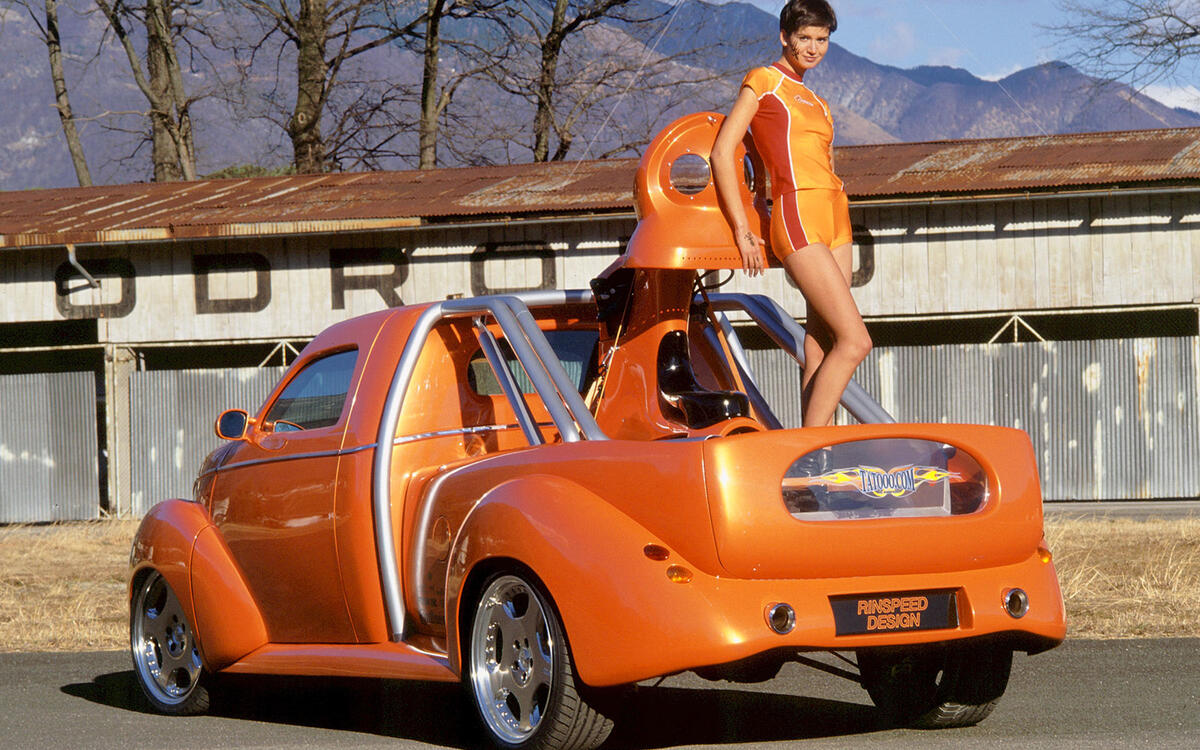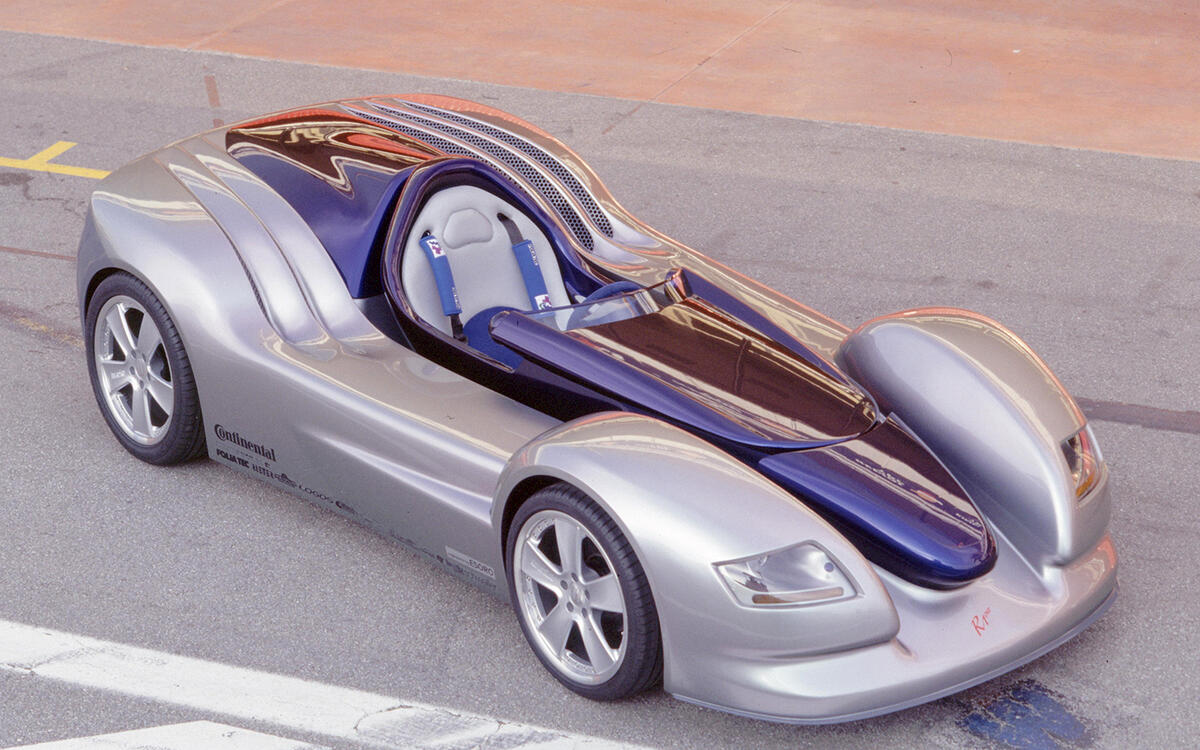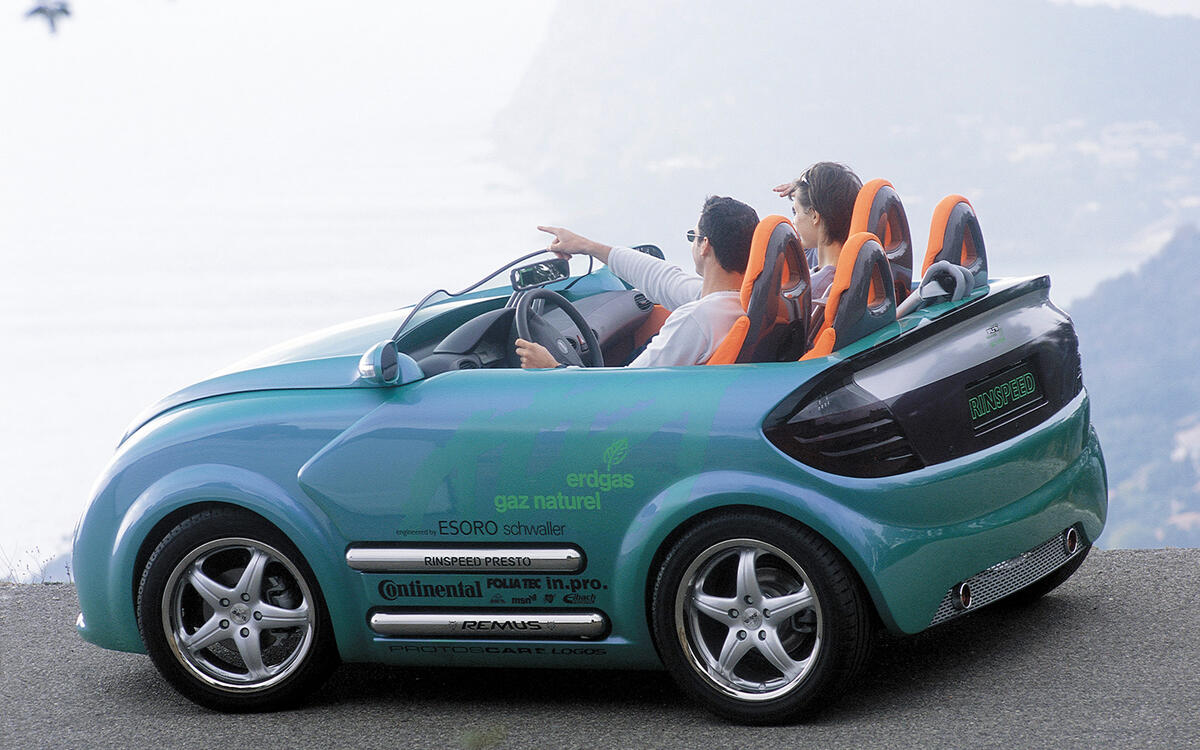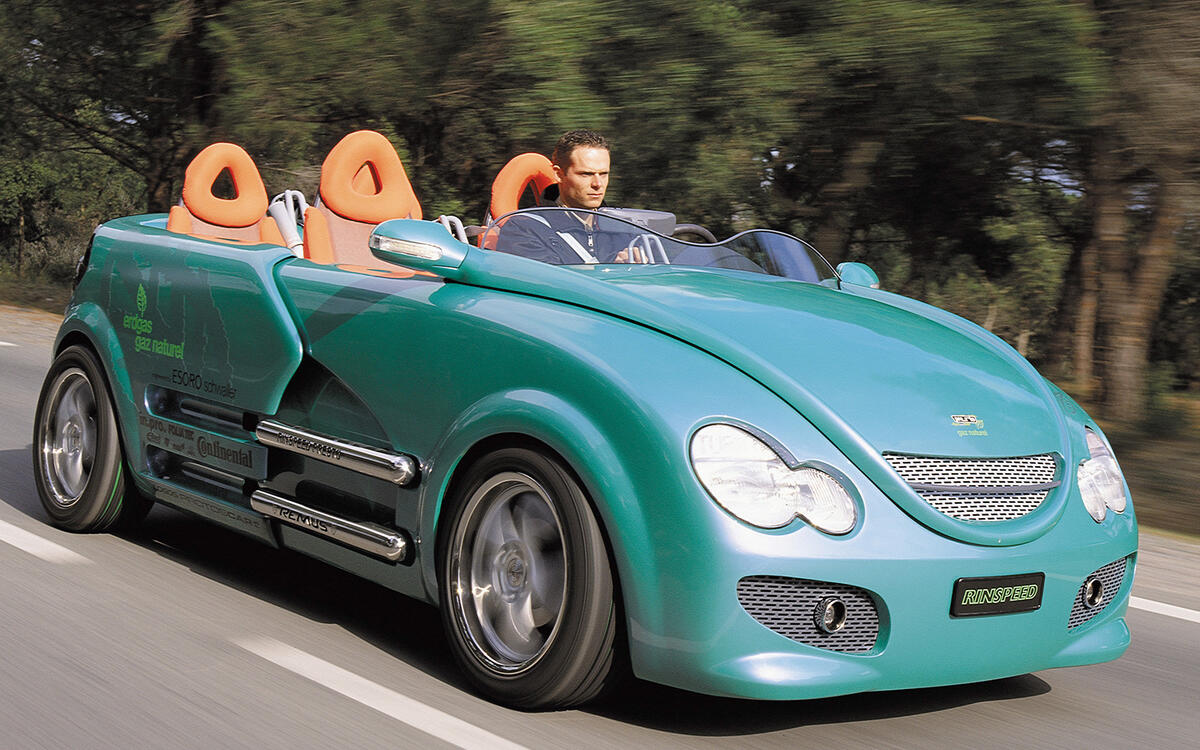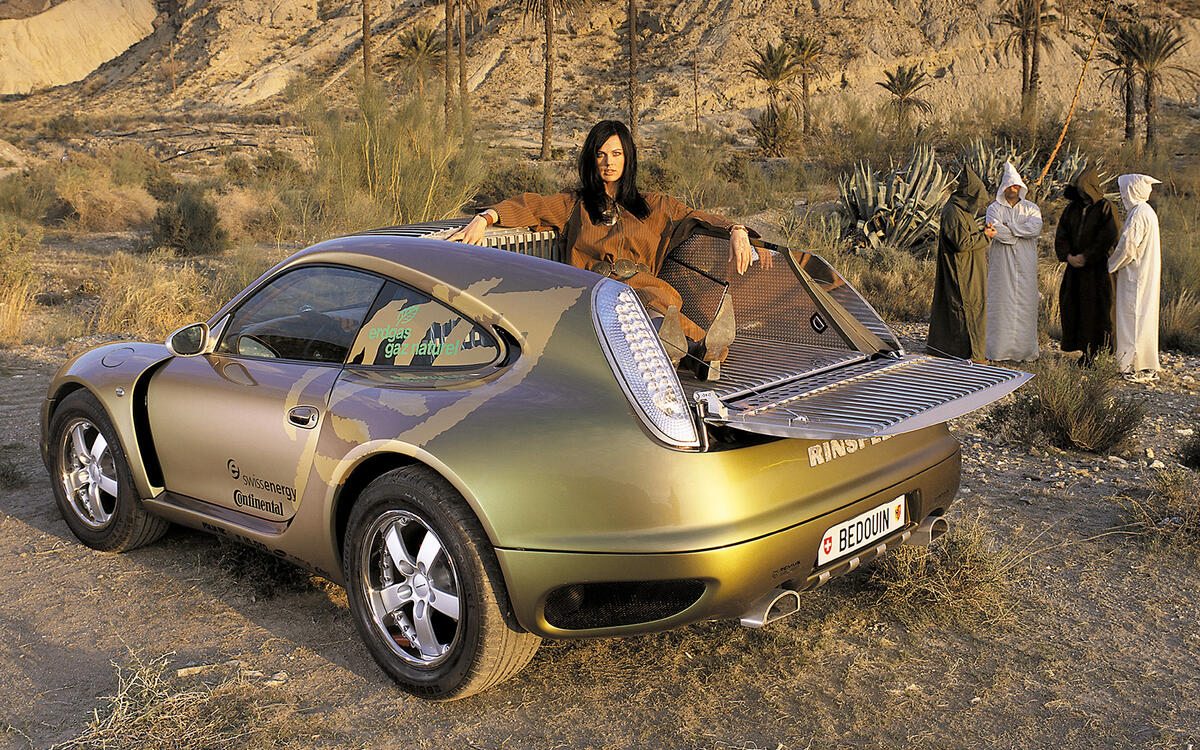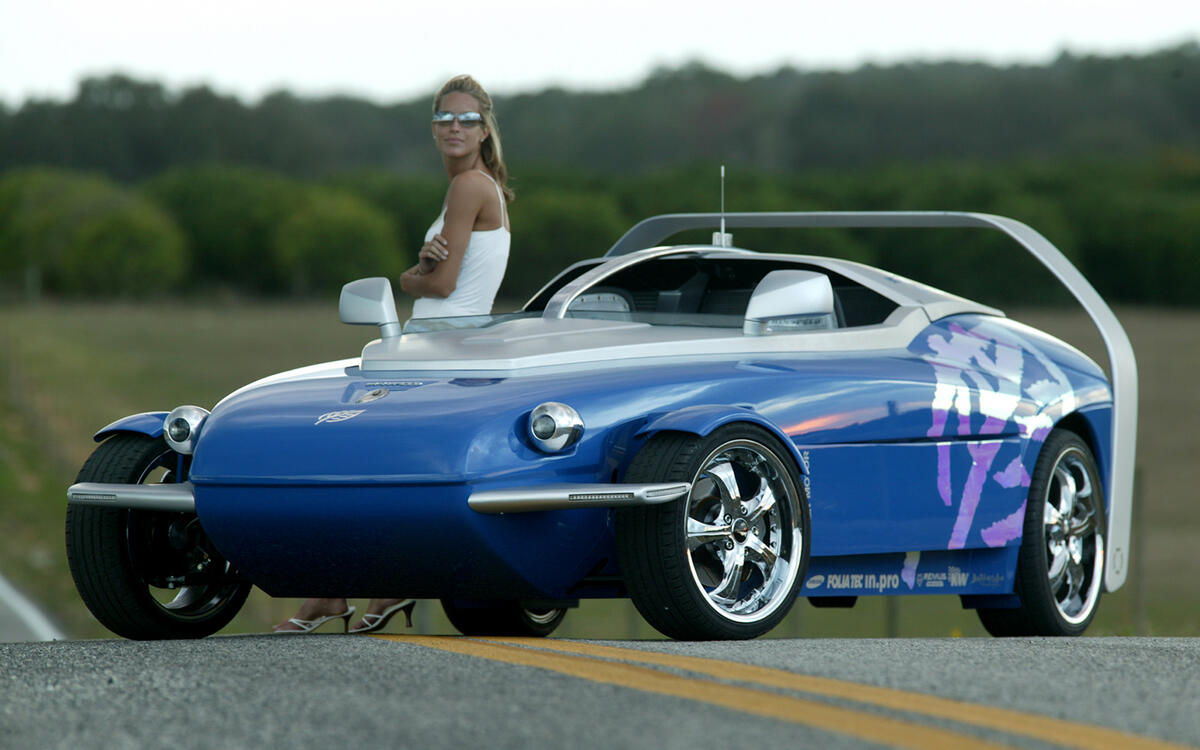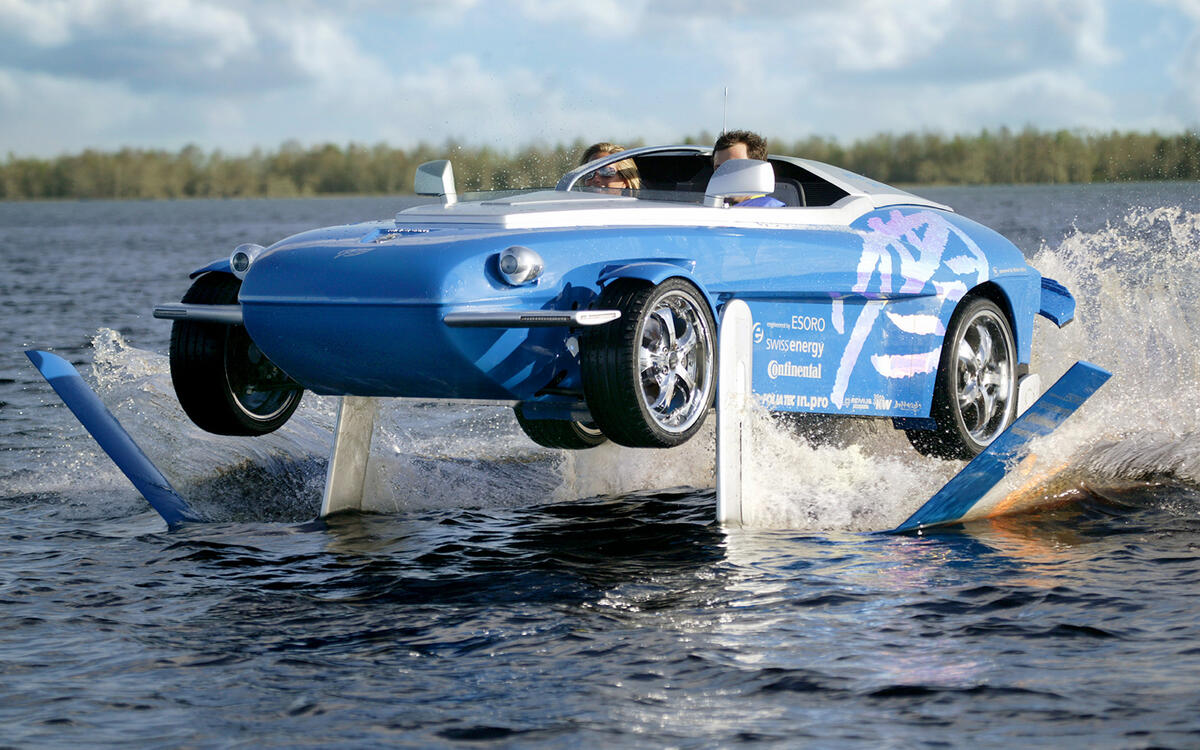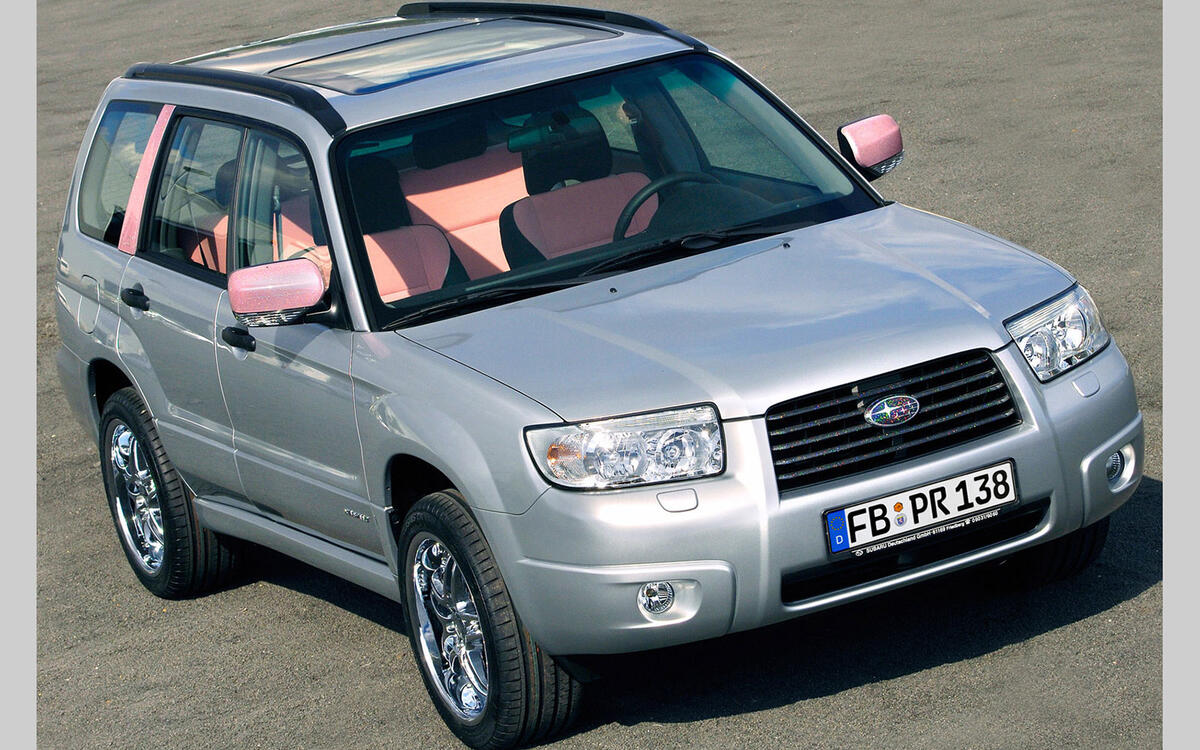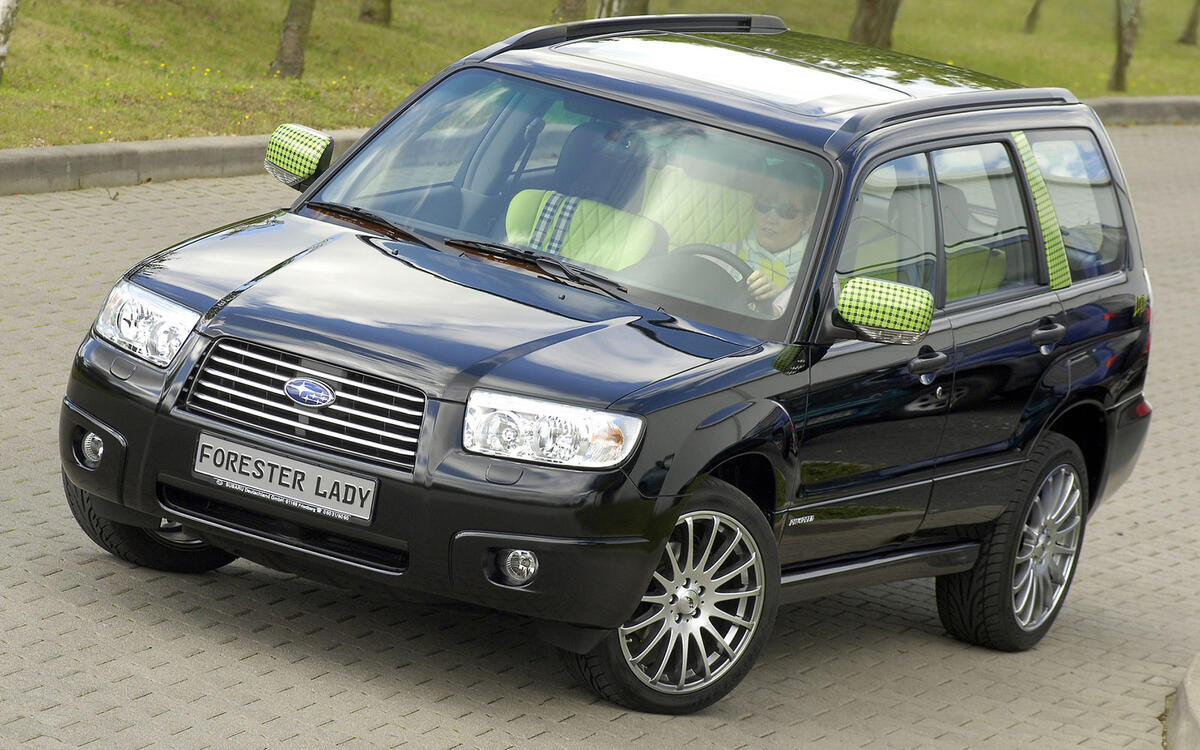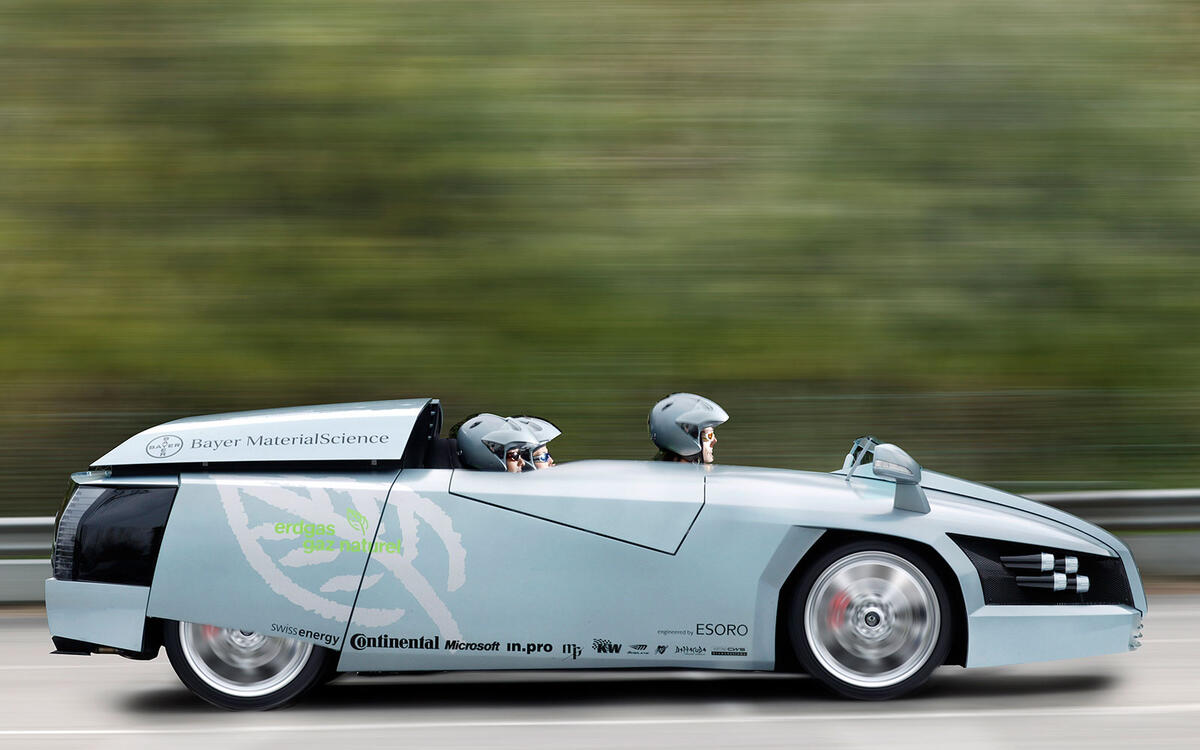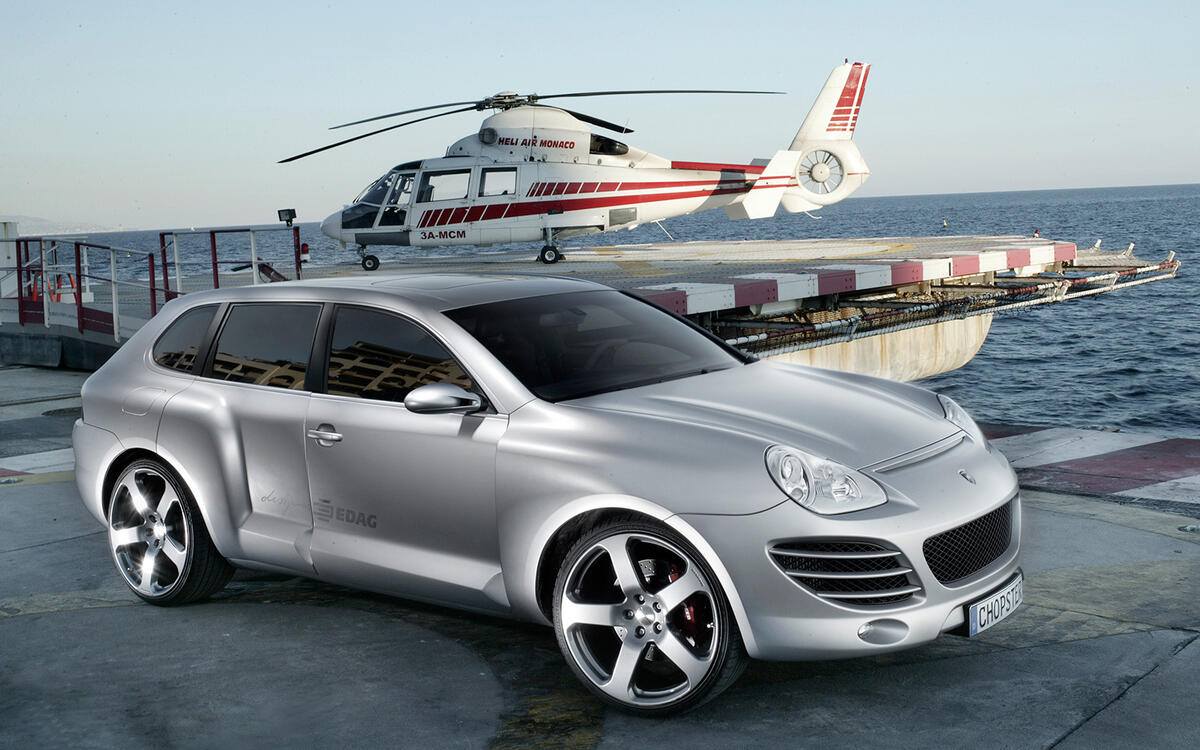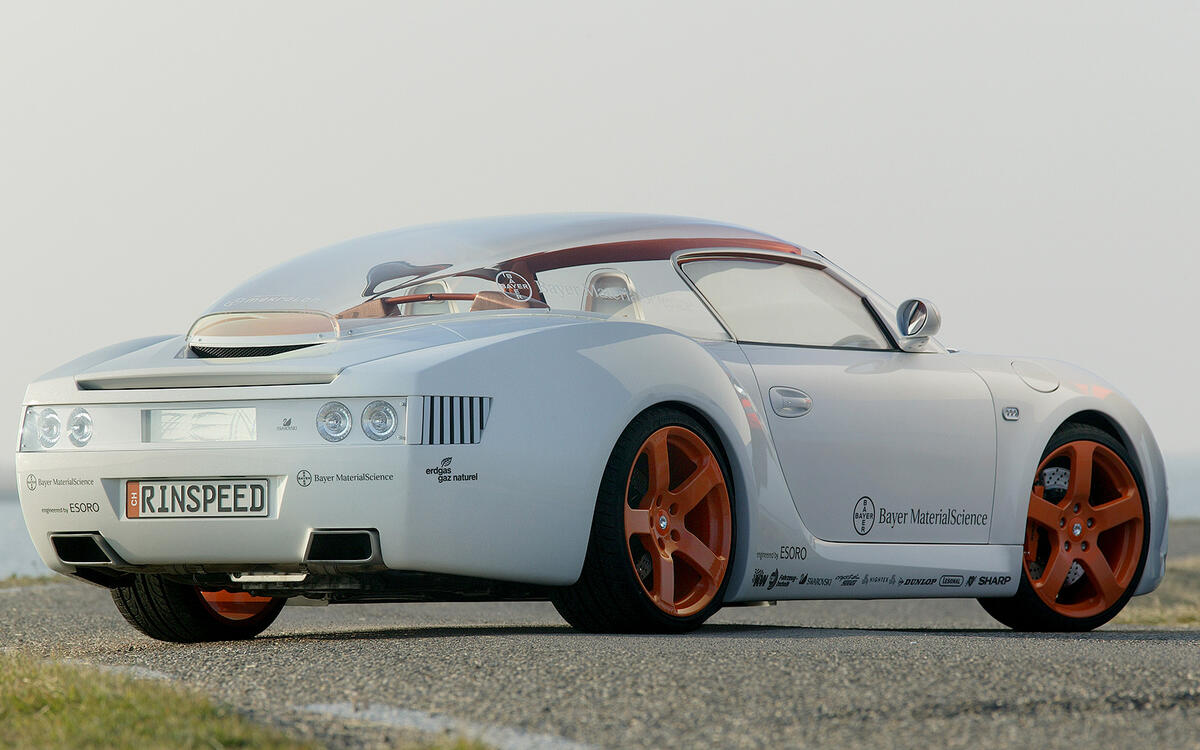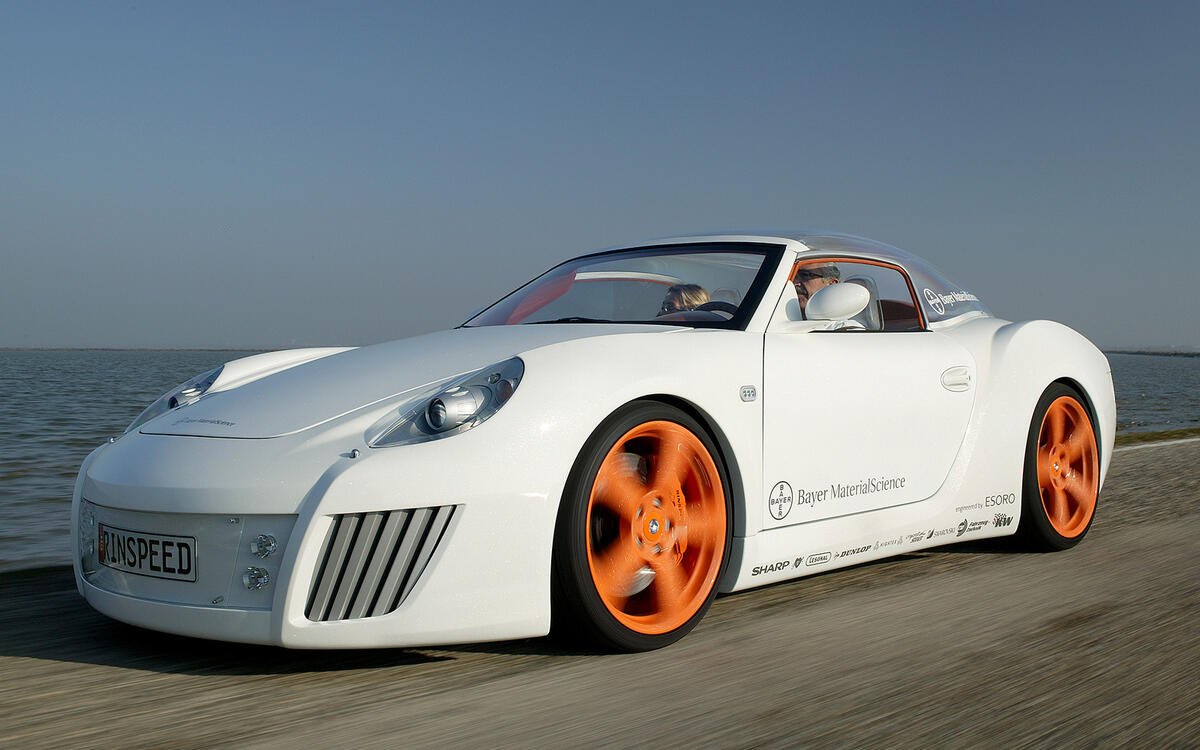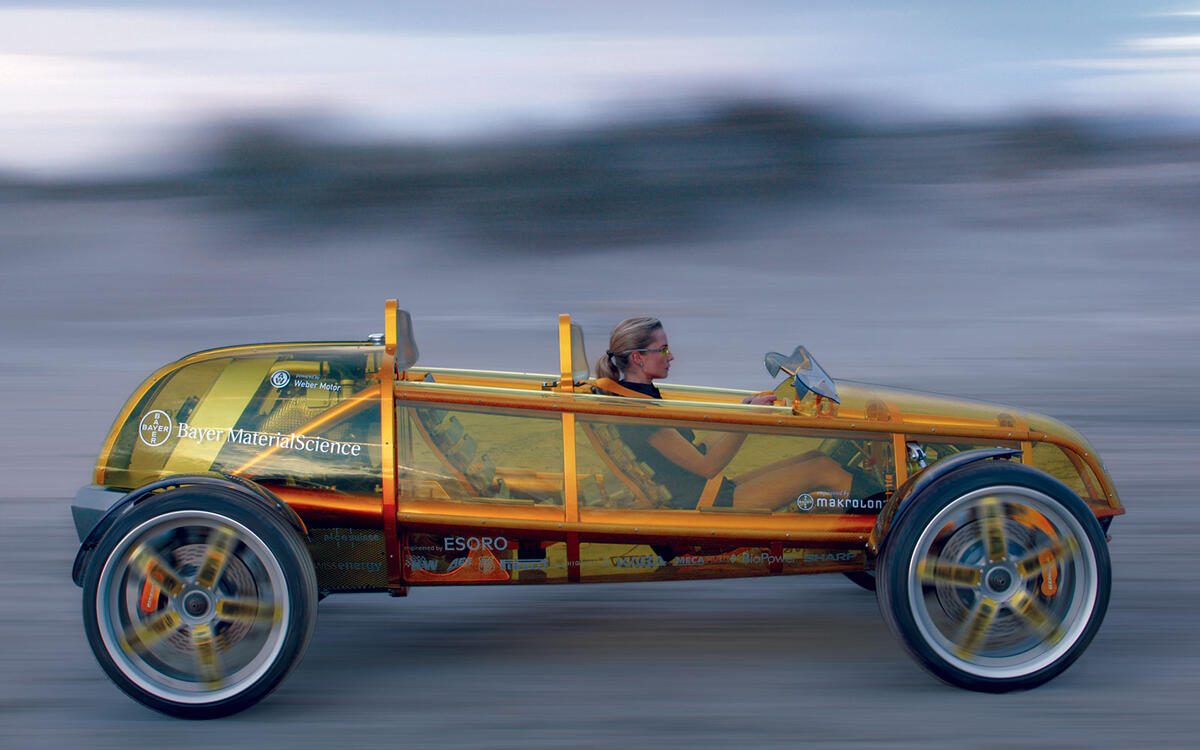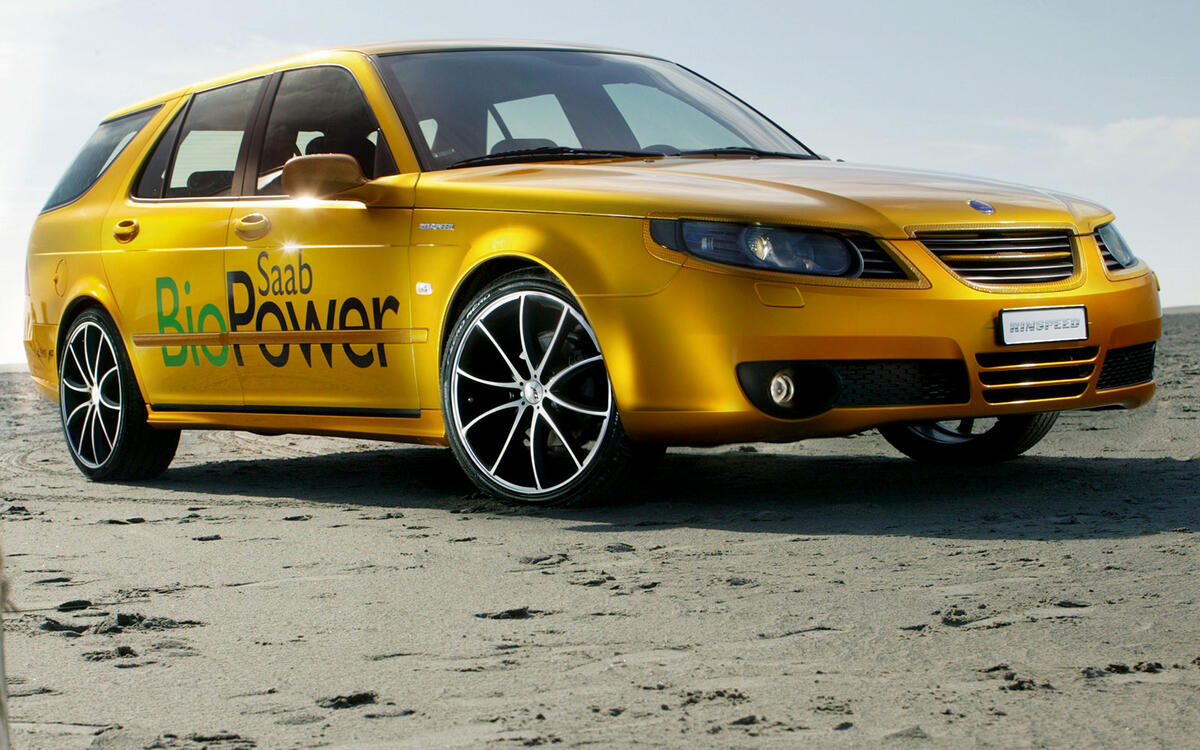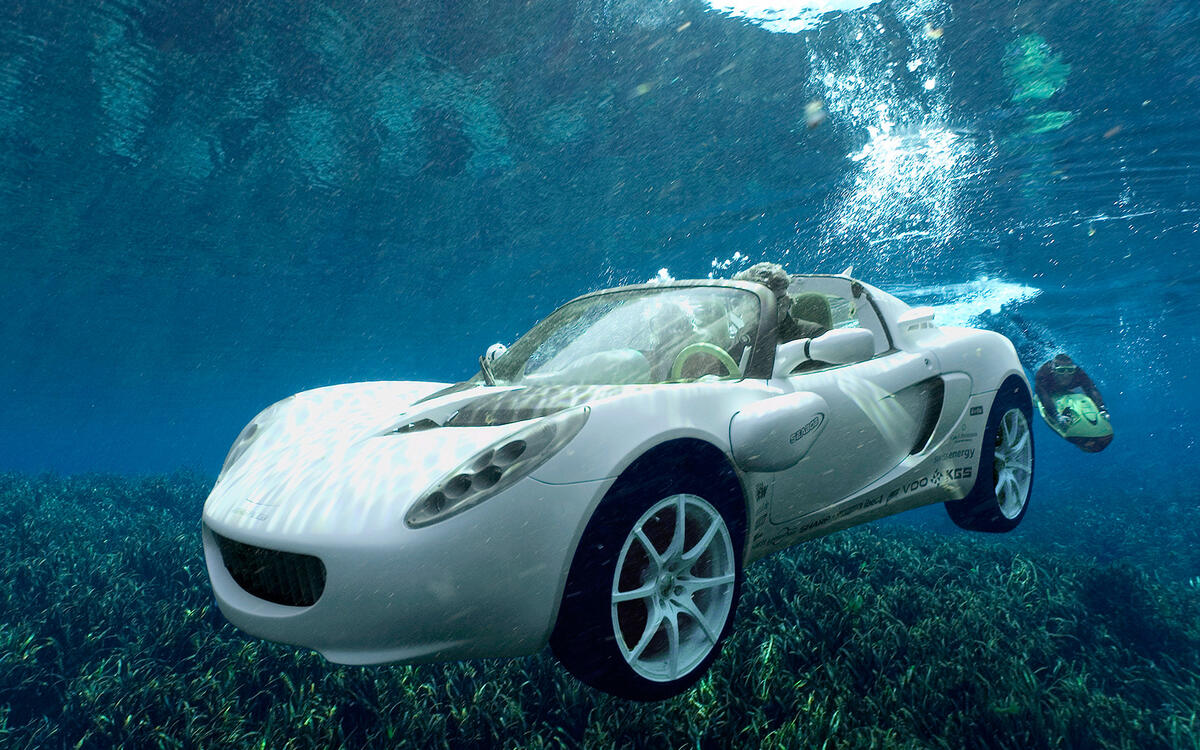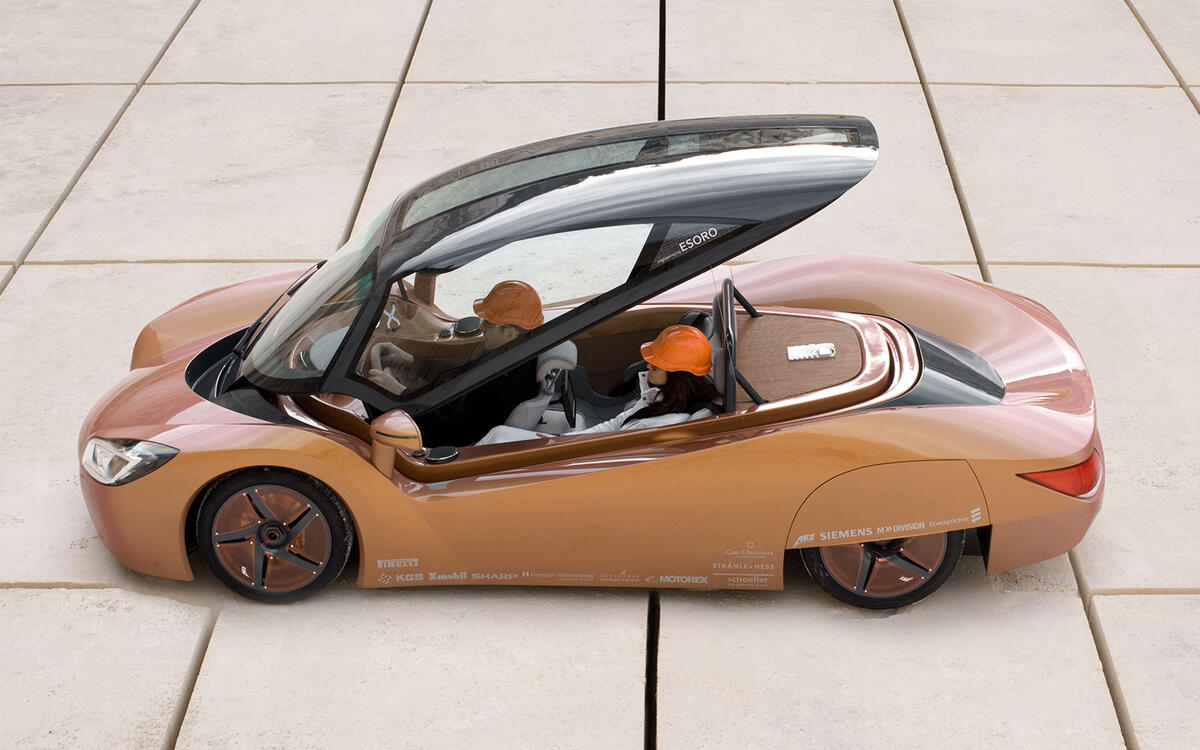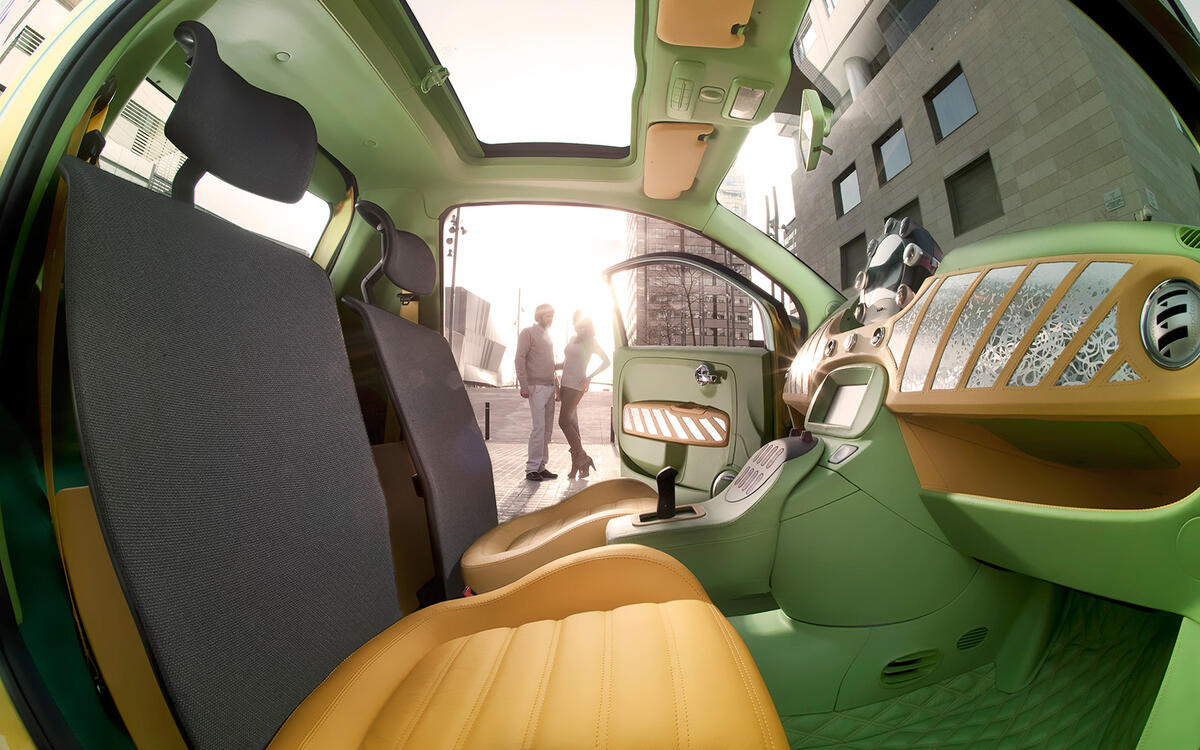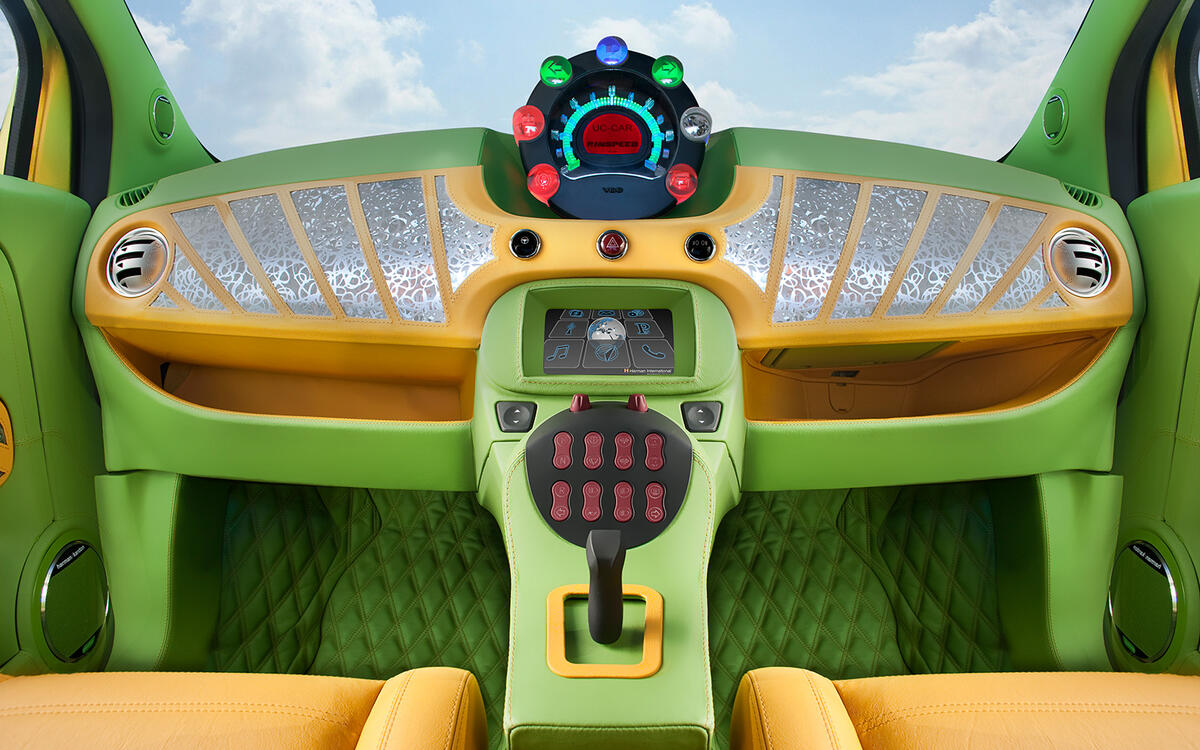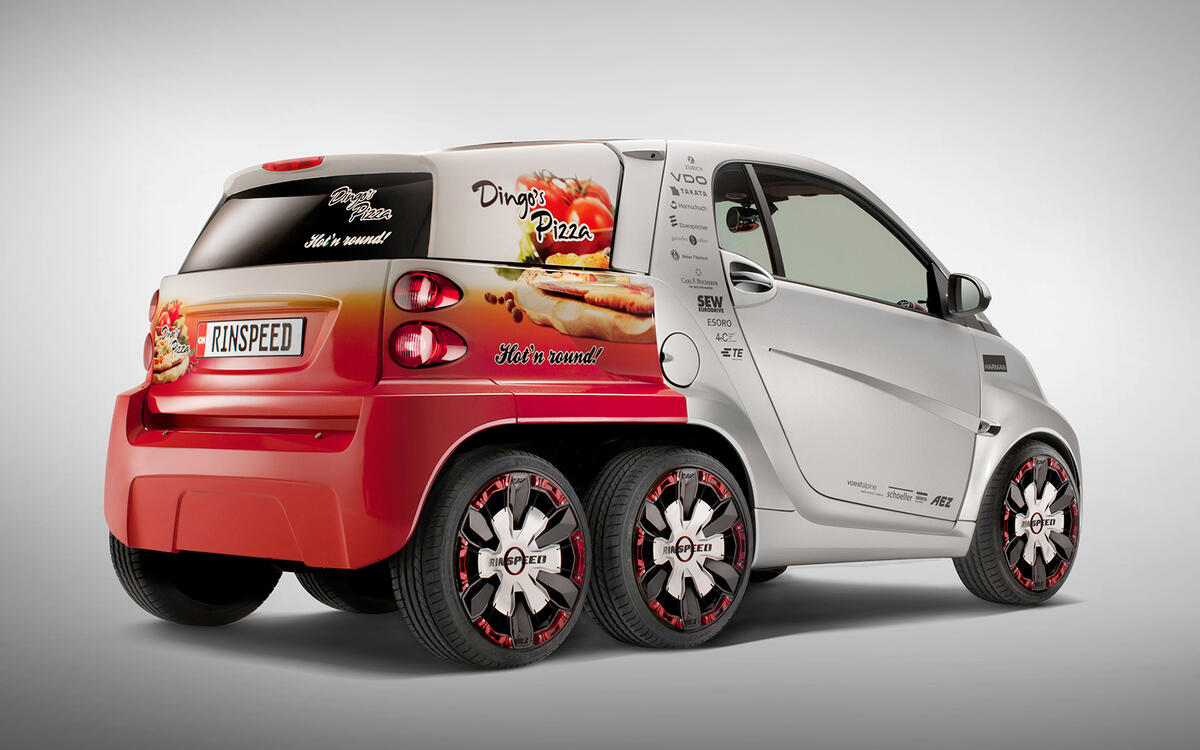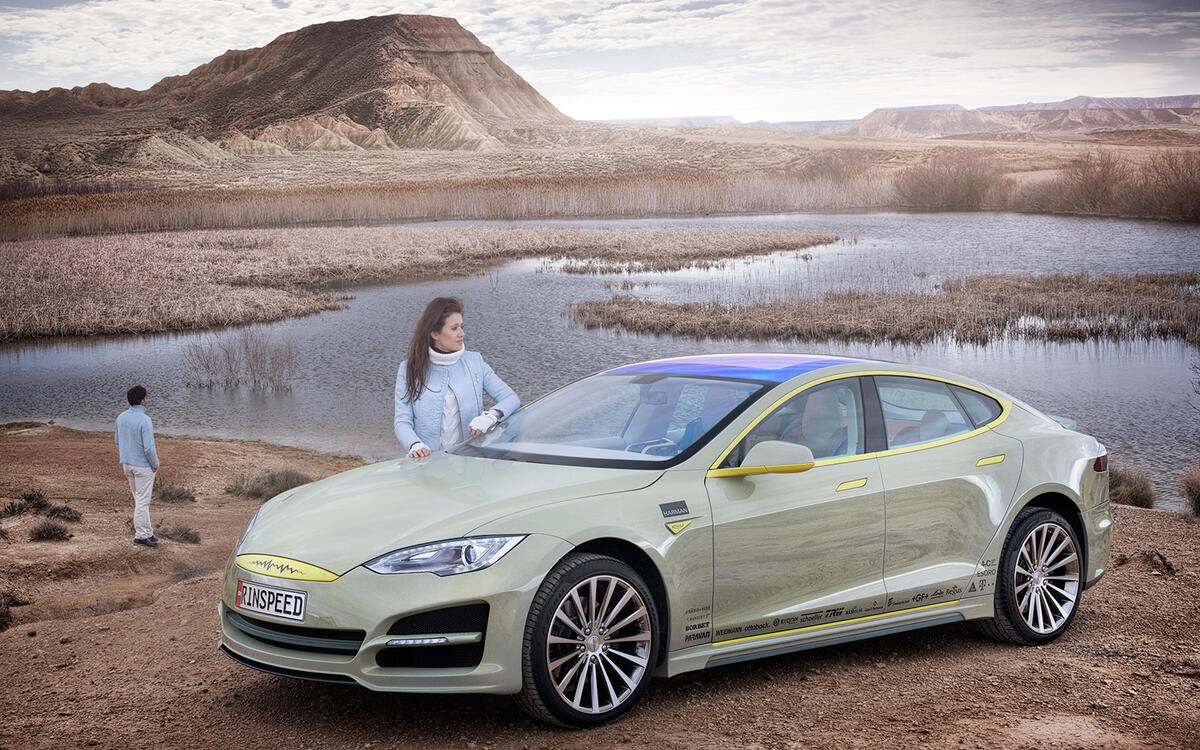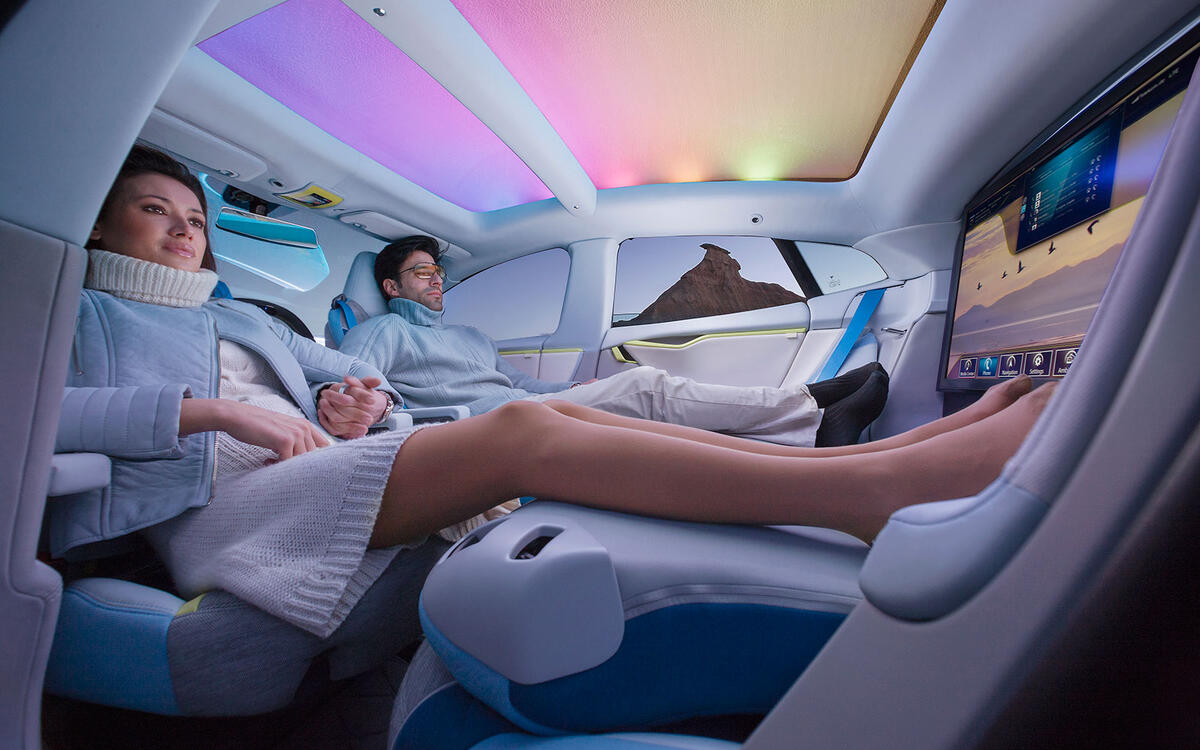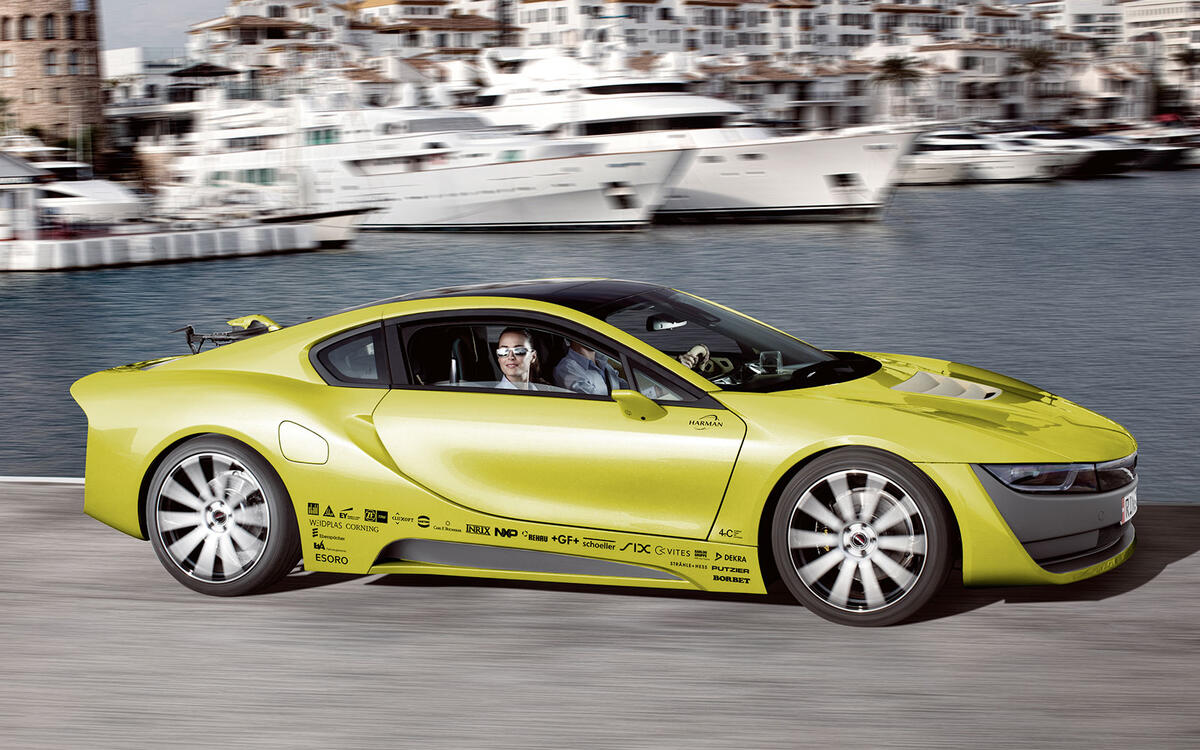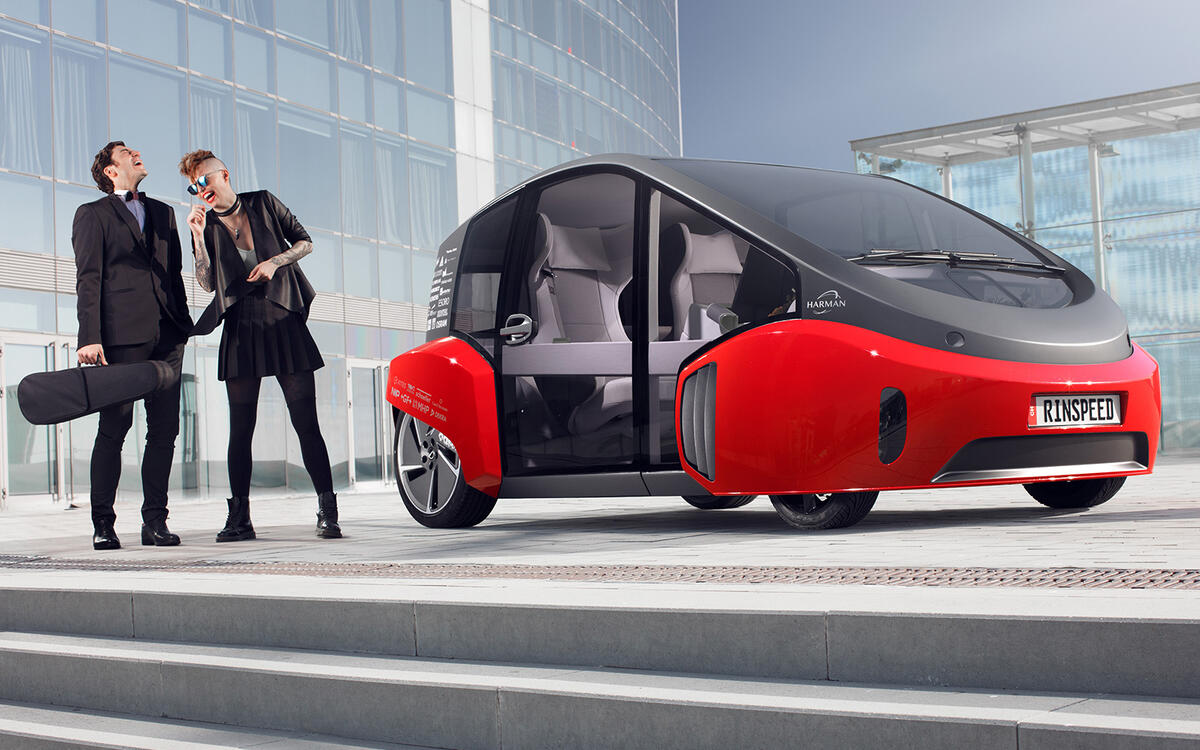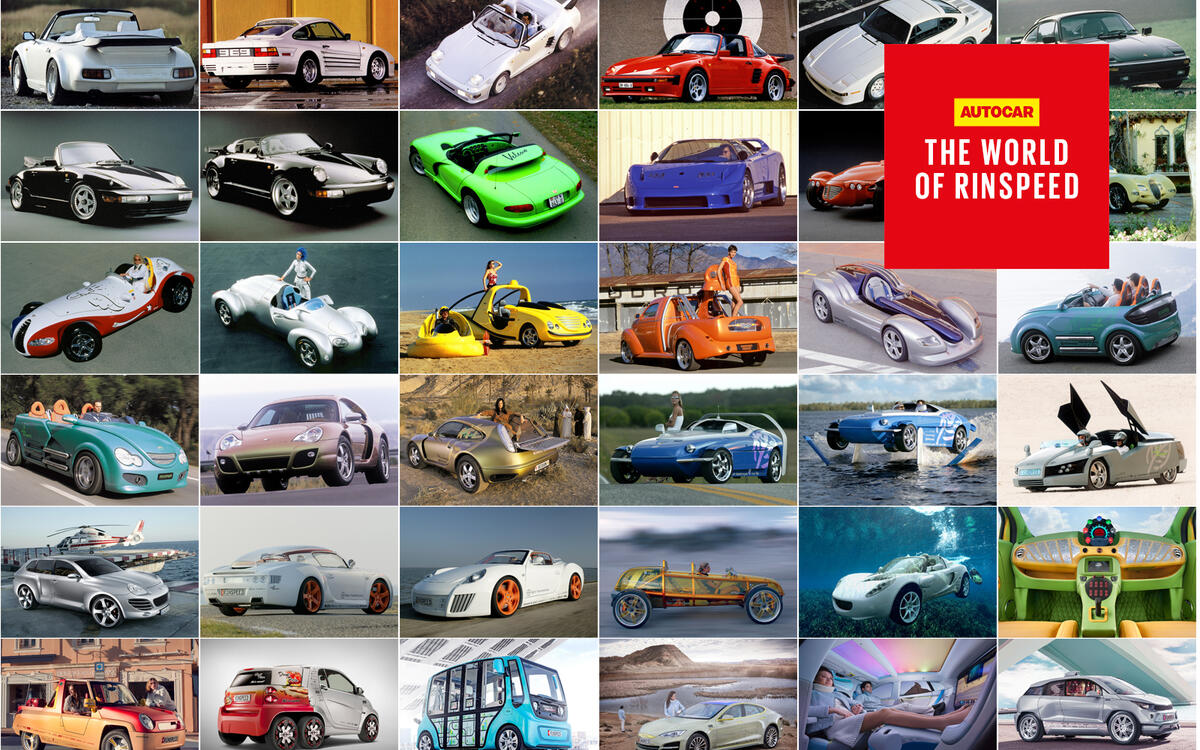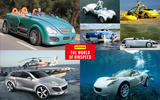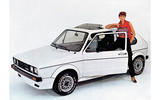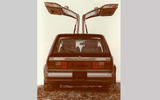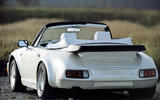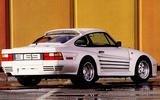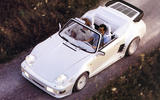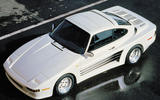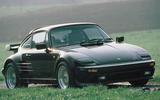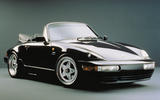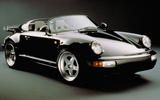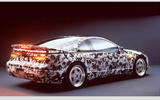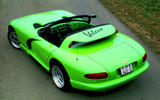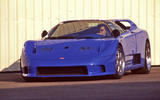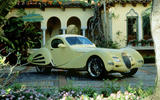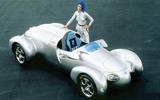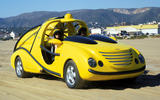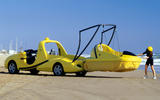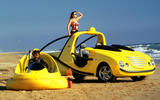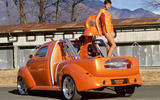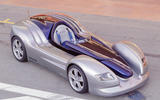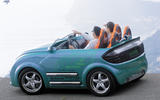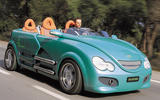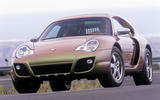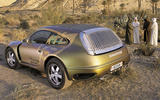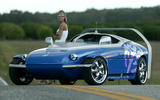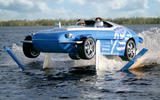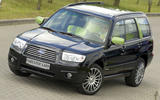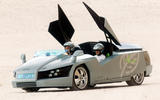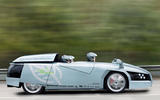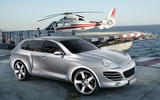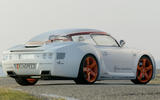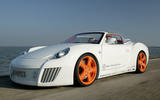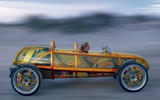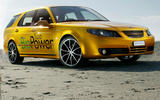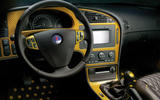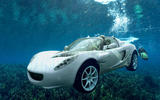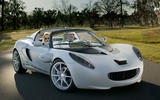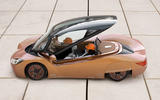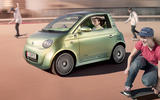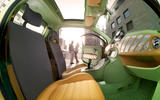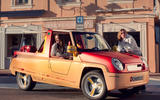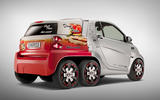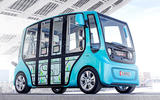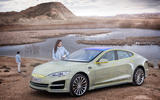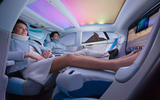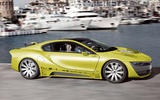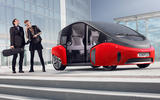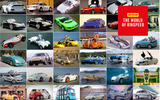 Slide of
Slide of
One of the constants of the Geneva motor show for the past four decades has been Frank Rinderkecht and his company Rinspeed.
What started out as an accessories company quickly became a high-profile tuning operation. The ensuing years have seen a multitude of mad projects emerge from this Swiss company, including an array of crazy concepts. Here’s how Rinspeed morphed from being a seller of sunroofs to one of the most creative concept car builders the world has ever seen.
 Slide of
Slide of
In the beginning
It all started in 40 years ago, when Rinspeed Garage was set up to import sunroofs from the US and convert cars for handicapped drivers.
 Slide of
Slide of
Golf Turbo (1979)
Rinspeed made its Geneva auto show debut in 1979 with a turbocharged Volkswagen Golf GTi. While the mechanical upgrades are interesting, the restyled nose pointed to Rinspeed’s future; this was the first Golf to feature rectangular headlights.
 Slide of
Slide of
Rinspeed Aliporta (1981)
Things started to get interesting in 1981, with Rinspeed unveiling the Aliporta, a Golf with gull-wing doors. The eighties were underway and so was Rinspeed’s rise to prominence as a company that wasn’t afraid to push the boundaries, especially with its work on Porsches.
 Slide of
Slide of
Rinspeed 939 (1983)
Rinspeed took the wraps off its first heavily modifed Porsche at the 1983 Geneva show – the 939 which came in coupé, cabriolet or targa flavours. At this point Porsche didn’t offer a 911 Turbo cabrio of its own; a factory-produced rag-top Turbo wouldn’t arrive for another two years.
 Slide of
Slide of
Rinspeed 969 (1985)
Rinspeed followed up the 939 in 1985, with the 969, a heavily modified Porsche 911 Turbo that was inspired by the Ferrari Testarossa, which at that point was the latest thing to come out of Maranello.
 Slide of
Slide of
Rinspeed R39
The 939 was so named because it blended elements of the 928 and 911, but Porsche had registered the 939 moniker which is why Rinspeed was forced to switched to R39 instead. This iconic shot from the mid-1980s shows Frank Rinderkecht at the wheel of an R39.
 Slide of
Slide of
Rinspeed R59
If you didn’t want your 911 to be mated with a 928 you could buy an R59 instead, which featured a different nose treatment with a standard rear end. You could buy your R59 in coupé or Targa forms.
 Slide of
Slide of
Rinspeed R69 (1985)
To fit in with Rinspeed’s new naming strategy the 969 became the R69. At the front there were pop-up headlamps while the rear was redesigned to incorporate 944 light clusters.
 Slide of
Slide of
Rinspeed R79
Flat-nose 911s became all the rage among wealthy collectors from the early 1980s, but you didn’t have to go to the factory to acquire one – Rinspeed was happy to build one for you.
 Slide of
Slide of
Rinspeed R89
If you fancied a cabriolet-based R59, Rinspeed was happy to build you one – but it carried R89 badges instead.
 Slide of
Slide of
Rinspeed Speedster (1991)
At the 1991 Geneva Salon, Rinspeed revealed its take on the 911 Speedster, based on the contemporary 964 Turbo with its 3.3-litre engine.
 Slide of
Slide of
Rinspeed SpeedArt (1992)
Created to mark 25 years of Nissan in Switzerland, the SpeedArt was unveiled in 1992. Based on a 300ZX and featuring 420 circus horses hand-painted by Rolf Knie, the SpeedArt featured larger turbos and intercoolers and a modified injection system to produce 420bhp.
 Slide of
Slide of
Rinspeed Veleno (1993)
Back in 1993 the Dodge Viper was one of the most outrageous cars you could buy, but in typical Rinspeed fashion too much was not enough. To boost the car’s presence the Veleno featured eye-searing green paintwork while nitrous injection upped the power from 400bhp to 550bhp.
 Slide of
Slide of
Rinspeed Cyan (1994)
Concerned that the Bugatti EB110 was maybe not exclusive enough, Rinspeed offered a package to allow some individuality. The result was the Cyan which arrived in 1994, with a reprofiled nose, restyled rear and an overhauled interior. Buyers could spec their own Cyan with prices starting at 600,000 Swiss Francs (around US$460,000 and £400,000 at the time) but unsurprisingly perhaps it seems just the one car was made.
 Slide of
Slide of
Rinspeed Roadster R and SC-R (1995)
Rinspeed achieved manufacturer status in 1995 and to mark the occasion it unveiled the Roadster R and SC-R at the Geneva motor show. The regular Roadster was fitted with a 5.0-litre Ford V8; the SC featured a supercharged version of the same engine, rated at 305bhp.
 Slide of
Slide of
Rinspeed (1996)
Rinspeed teamed up with Swiss pop duo Yello to create this incredible machine, inspired by a 1938 Figoni & Falaschi-bodied Talbot Lago 150 SS. Unveiled at the 1996 Geneva show, once again power came from a supercharged Ford V8, this time rated at 320bhp.
 Slide of
Slide of
Rinspeed Mono Ego (1997)
To celebrate its 20th birthday in 1997, Rinspeed created the Mono Ego in conjunction with a raft of other companies; the result was a car fully compliant with all EU regulations. Power - all 410bhp of it - came from a supercharged V8 to give a claimed top speed of 161mph.
 Slide of
Slide of
Rinspeed E-Go Rocket (1998)
Inspired by the Utah salt flat racers of the 1940s, the E-Go Rocket made its debut at the 1998 Geneva salon. Once again the car met all EU regulations and as with the Mono Ego, power came from a Ford-supplied 32-valve all-aluminium V8, with 410bhp on tap in supercharged form.
 Slide of
Slide of
Rinspeed X-Trem (1999)
The 1999 Geneva show car was even more bonkers than usual. The X-Trem (sometimes known as the X-Dream) was billed as a Multi-Utility Vehicle which was effectively a pick-up with a built-in crane (dubbed Xtra-lift) that allowed a jet-ski or motorbike to be carried in the rear.
 Slide of
Slide of
Rinspeed X-Trem
It’s fair to say that the X-Trem was rather challenged stylistically, and the market was also undoubtedly rather small which is why nobody else has jumped onto the MUV bandwagon.
 Slide of
Slide of
Rinspeed X-Trem
This time power came from a Mercedes 5.5-litre V8; the 347bhp lump could take the X-Trem all the way to 147mph. Which must have been frightening.
 Slide of
Slide of
Rinspeed Tatooo (2000)
When the Tatooo was revealed at the 2000 Geneva show, Rinspeed claimed that “the play on words combines the emotional, erotic appeal of human body art with the three zeros that have come to symbolize the new millennium”. Er, right. It was basically a pick-up inspired by 1950s hot rods.
 Slide of
Slide of
Rinspeed Tatooo
The Xtra-lift that had been introduced on the X-Trem was carried over. Because you just can’t get too much of a good thing. In true hot-rod tradition the Tatooo packed a 5.7-litre V8, tuned to give 409bhp.
 Slide of
Slide of
Rinspeed R-One (2001)
Designed to be a race-bred single-seater for the road, you couldn’t accuse the R-One of being a looker. When it was unveiled in 2001 the R-One was claimed to be the world’s lowest driveable sports car; its other claim to fame was that it could run on biofuel created from kitchen waste. Its rear-mounted 1.8-litre four-pot engine was rated at 120bhp.
 Slide of
Slide of
Rinspeed Presto (2002)
Can’t choose between a two-seater convertible and a four-seater? Why not have both in one, with the Presto, revealed at the 2002 Geneva motor show? At the press of a button the car extended by 70cm...
 Slide of
Slide of
Rinspeed Presto
...so you could drive around with three empty seats instead of just the one. Because let’s face it, nobody would want to be seen in this monstrosity. As the looks suggest, Mercedes provided the motive power for the Presto, in the form of a 1.7-litre turbodiesel engine.
 Slide of
Slide of
Rinspeed Bedouin (2003)
When it comes to makeovers, few are as extreme – or bonkers – as the Rinspeed Bedouin that appeared in 2003. Clearly derived from the Porsche 996, the Bedouin was the world’s fastest car capable of running on natural gas.
 Slide of
Slide of
Rinspeed Bedouin
By the time the Bedouin was being designed, Rinspeed had got a taste for cars that could convert themselves from one form to another. As a result this 420bhp supercharged off-roader could transform from being a pick-up...
 Slide of
Slide of
Rinspeed Bedouin
... to a shooting brake. Everything was electrically powered of course, with the transformation taking under half a minute.
 Slide of
Slide of
Rinspeed Splash (2004)
Amphibious vehicles have never been very successful from a sales point of view, but that didn’t stop Rinspeed from unveiling the Splash at the 2004 Geneva motor show.
 Slide of
Slide of
Rinspeed Splash
Powered by a turbocharged 750cc two-cylinder engine, the 140bhp Splash could top 45 knots (52mph) on water and 124mph on land.
 Slide of
Slide of
Rinspeed Forester Lady (2004)
In 2004 Rinspeed introduced the Forester Lady, apparently an attempt to turn a Subaru into something “more female-friendly”.
 Slide of
Slide of
Rinspeed Forester Lady 2
For those women who managed to resist the charms of a pink cabin, Rinspeed came up with a lime green alternative. Nice.
 Slide of
Slide of
Rinspeed Senso (2005)
For 2005 Rinderknecht came up with the soundbite: “The driver and not the technology should be the focal point of a car”. To this end the Senso was fitted with an array of sensors that could measure the driver’s biometric data.
 Slide of
Slide of
Rinspeed Senso
Using this data, the Senso could adjust the cabin’s colours, music, temperature and fragrances to make the driver more alert while also relaxing them.
 Slide of
Slide of
Rinspeed Chopster (2005)
The Senso wasn’t the only Rinspeed delight at the 2005 Geneva motor show; there was also the Chopster. With a roof chopped by 70mm and bulging wing extensions this wasn’t the kind of project that Rinspeed usually got involved in, but when you get the chance to create a looker like this...
 Slide of
Slide of
Rinspeed zaZen (2006)
Compared with some of the mad machines to come out of Rinspeed, the zaZen that arrived in 2006 was rather tame. Indeed it looked like little more than a Porsche Cayman with a dome perched on top.
 Slide of
Slide of
Rinspeed zaZen
When it was unveiled, Rinderknecht said that the zaZen represented his vision of the future, although it wasn’t really all that futuristic. The flat-six engine was pinched from a 997 Carrera S, which meant it was a 335bhp unit that powered the rear wheels via a six-speed manual gearbox.
 Slide of
Slide of
Rinspeed eXasis (2007)
With Rinspeed celebrating its 30th birthday in 2007, Rinderknecht was keen to push the boundaries once more. It’s fair to say he did that with the eXasis, with a bodyshell made of transparent plastic. Weighing just 750kg, the eXasis was fitted with a 150bhp engine that ran on bioethanol.
 Slide of
Slide of
Saab 9-5 Rinspeed (2007)
In 2007 Saab teamed up with Rinspeed to create a 9-5 estate that was more eye-catching than usual. The biopower-fuelled car was little more than a styling exercise...
 Slide of
Slide of
Saab 9-5 Rinspeed
... which is why this golden 9-5 shouldn’t really warrant a mention here. But we couldn’t deny you the magnificence of this dashboard. Just soak it up. Lovely.
 Slide of
Slide of
Rinspeed sQuba (2008)
Amphibious cars were nothing new when the sQuba appeared in 2008, but Rinspeed went a stage further with this Lotus Elise-based car which could be driven under-water as well as on the surface.
 Slide of
Slide of
Rinspeed sQuba
Inspired by James Bond's Lotus Esprit from 1977's The Spy Who Loved Me, the zero-emissions sQuba was powered by three electric motors; one for driving on land and two for propulsion in the water.
 Slide of
Slide of
Rinspeed iChange (2009)
Billed as “the world’s first car whose body adapts to the number of passengers on board“, the 2009 iChange was a single-seater sports car that transformed into a three-seater at the push of a button, with the rear end of the teardrop-shaped car popping up. We’ve watched the video and it’s a lot less impressive than it sounds.
 Slide of
Slide of
Rinspeed UC (2010)
The UC (Urban Commuter) was an electric city car that could manage 75 miles on a charge and could reach almost 70mph flat out.
 Slide of
Slide of
Rinspeed UC
Unveiled in 2010, the UC concept was driven via a joystick rather than with conventional controls.
 Slide of
Slide of
Rinspeed UC
The best part though was the sombre interior, which we love for its understated colours.
 Slide of
Slide of
Rinspeed Bamboo (2011)
Think of this as a 21st century Citroen Mehari. When the Bamboo was revealed at the 2011 Geneva salon it was billed as a beach car for the modern age – a car that could go anywhere rather than be restricted to metalled roads.
 Slide of
Slide of
Rinspeed Bamboo
Innovations crammed into the Bamboo included an inflatable roof that doubled as a beach blanket and an electric drivetrain with a range of around 65 miles.
 Slide of
Slide of
Rinspeed Dock+Go (2012)
The idea of a six-wheeled Smart ForTwo might seem crazy, but that didn’t stop Rinspeed from pulling the wraps off just such a creation at the 2012 Geneva show. The idea was that you could drive the Smart in regular four-wheeled mode most of the time, but when you needed the extra capacity you just attached a module onto the rear to give you extra carrying capacity.
 Slide of
Slide of
Rinspeed microMAX (2013)
When it was unveiled at the 2013 Geneva salon, the release claimed that “With microMAX Rinspeed transfers the idea of swarm intelligence to urban traffic and sets out to do nothing less than to revolutionise it”. This pure electric box on wheels was apparently created for those who wanted to buy their own car, lift share, hail a taxi, car share, rent. So pretty much the same as any family car ever created then.
 Slide of
Slide of
Rinspeed XchangeE (2014)
Rinspeed still hadn’t got to grip with the shift key when the XchangE arrived in 2014, but it had seen that autonomous tech was about to become the must-have feature.
 Slide of
Slide of
Rinspeed XchangeE
The result was a pure-electric luxury car that could drive itself. While the XchangE didn’t actually feature a full suite of autonomous features, it was designed on the basis that such technology was just around the corner.
 Slide of
Slide of
Rinspeed Budii (2015)
Seemingly inspired by the BMW i3, the Budii made its debut at the 2015 Geneva salon. The Budii was Rinspeed’s take on what an autonomous car should be like, complete with vehicle-to-vehicle (V2V) and vehicle-to-infrastructure (V2X) radio-based communications, radar and motion sensing systems including advanced camera monitoring.
 Slide of
Slide of
Rinspeed Etos (2016)
For the first time ever, Rinspeed didn’t unveil its new creation at the Geneva motor show in 2016. Instead it was at the Consumer Electronics Show in Las Vegas that we got our first glimpse of the Etos, a car based on the BMW i8. Once again Rinspeed was providing a glimpse of an autonomous future, this time powered by a petrol-electric hybrid powertrain.
 Slide of
Slide of
Rinspeed Oasis (2017)
Unveiled at 2017’s Consumer Electronics Show, the Oasis comes equipped with a heated drawer for carrying pizzas and a space in the dash to grow radishes (yes – really!). Let’s face it, the Oasis is obviously what we all need in our lives.
 Slide of
Slide of
2018-
What does the future for Rinspeed look like? Though now 61 years of age, there are few signs that Frank Rinderknecht is contemplating retirement any time soon. We certainly hope not, for there are no dull moments when Rinspeed is busy.
The maker of bonkers concepts and conversions was born in 1977
Advertisement

